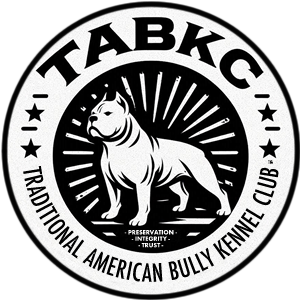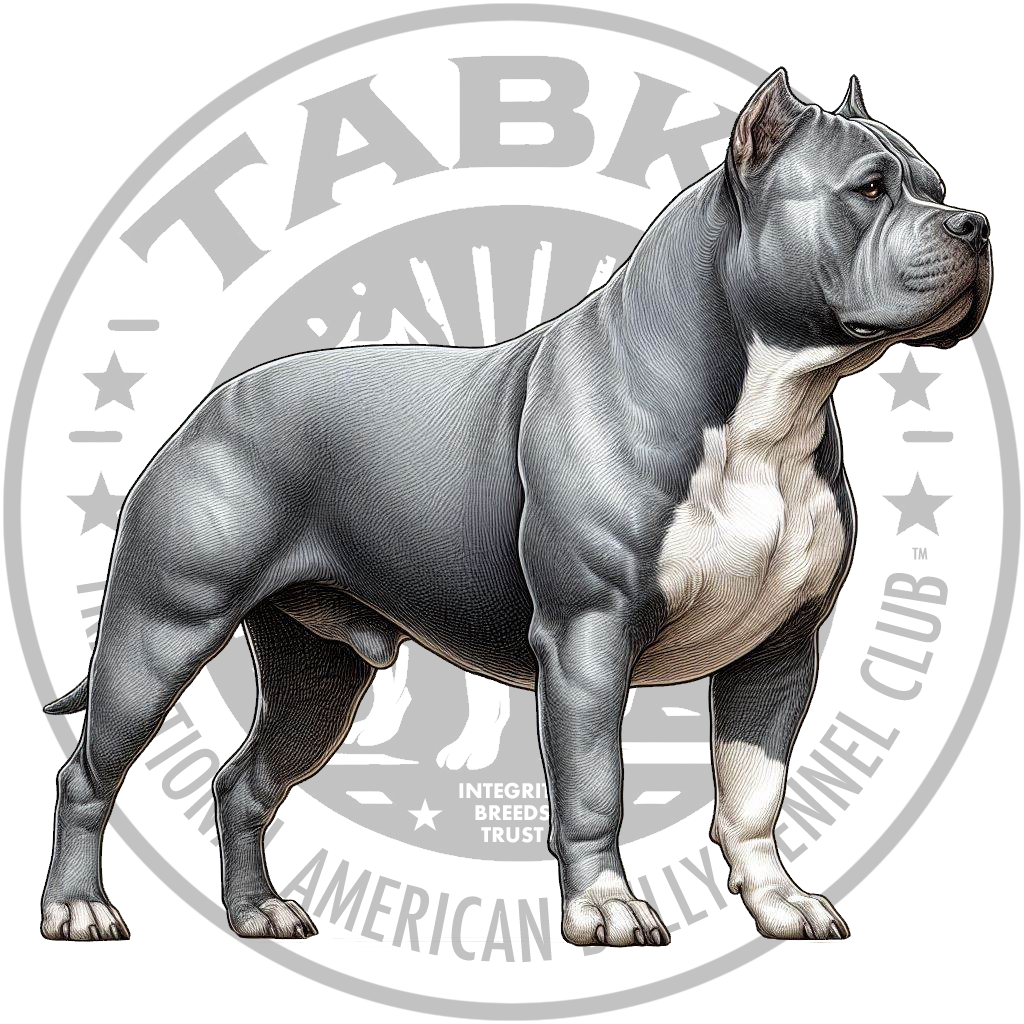Breed Standard
#appearance #characteristics #head #teeth #eyes #ears #neck #body #forequarters #hindquarters #feet #tail #height #coat #color #gait #eliminations #disqualifications #pedigree #examples #traditional-vs-modern #suggestions
GENERAL APPEARANCE
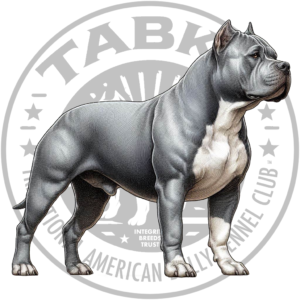
Traditional American Bully Breed Characteristics [Top]
The Traditional American Bully’s appearance has remained fairly consistent since the 1990s-2000s, and reflects a subtle blend of bull breeds.
Key features include:
- Balance and Proportions: Essential for a harmonious overall appearance
- Muscle Tone and Soundness: Absolute necessities for a healthy, athletic build
- Coat: Smooth and sleek
- Strength and Agility: Exceptional power and agility relative to its size
- Presence: Exudes confidence, power, stamina, and a loyal temperament
Faults to Eliminate
- Any exaggerated feature that hinders physical activity
Disqualifications
Unilateral or bilateral cryptorchid (undescended testicles)
CHARACTERISTICS
The American Bully: A Loyal Companion [Top]
The Traditional American Bully breed is a companion breed first and foremost. All other aspects of the breed are secondary.
At its core, the Traditional American Bully breed is a devoted companion, radiating confidence and a joyful enthusiasm for life. Beneath its powerful exterior lies a gentle and friendly nature, making it an exceptional family dog.
Although it is highly versatile, the Traditional American Bully is not intended to be a working breed, and not a protection breed. Overprotectiveness is undesirable. Companionship and show are its primary purposes. This requires a gentle disposition.
Key Characteristics
- Confident and Exuberant: Zestful approach to life
- Gentle and Friendly: Ideal temperament for a family pet
- Athletic: Possesses the agility and endurance for performance events
Unacceptable Traits
- Aggressive behavior towards humans is contrary to the breed’s nature and highly undesirable
Disqualifications
Extreme Shyness: Excessive fearfulness or timidity
Viciousness: Displaying extreme aggression
HEAD
American Bully Breed Head Characteristics [Top]
The American Bully’s head is a distinctive feature, boasting a unique blend of size, shape, and proportions. Key attributes include:
Skull
- Large and Broad: Yet always in harmony with the overall dog
- Flat Top: No dome between the ears
- Defined Stop: Moderately deep and well-defined
Muzzle
- Broad and Blocky: Or slightly square in shape
- Length: Shorter than the skull, comprising roughly 1/3 of the head’s overall length
- Straight Top: No curvature or deviation
- Well-Developed Lower Jaw: Wide and deep, with no weakness
Nose
- Large: With well-opened nostrils
- Pigment: All colors acceptable, typically harmonizing with coat color
Faults to Eliminate
Nose Deviation: Upturned or pushed back, disrupting the head’s harmony
Excessive Head Size: Disproportionate to the body
Respiratory Interference: Muzzle too short and blunt, hindering normal breathing
Snipey Muzzle: Narrow and pointed
Weak Lower Jaw: Lacking development or substance
Excessive Flews: Loose or flaccid lips
TEETH
American Bully Dental Characteristics [Top]
The American Bully’s dental structure is characterized by:
- Complete Set: A full complement of teeth
- Even Spacing: Uniformly arranged for optimal biting and chewing
- White Teeth: Clean and healthy, with no discoloration
- Scissors or Even Bite: Teeth meet in a precise, harmonious alignment
Serious Faults
- Missing Teeth: Any gaps or missing teeth are considered a significant flaw
Eliminating Faults
- Undershot Bite: Lower teeth protrude beyond the upper teeth
- Overshot Bite: Upper teeth protrude beyond the lower teeth
- Wry Bite: Teeth are misaligned, causing an uneven bite
Note: These faults can affect the dog’s overall health, comfort, and ability to eat and function properly.
EYES
American Bully Eye Characteristics [Top]
The American Bully’s eyes are defined by:
- Medium Size: Neither too large nor too small
- Oval to Almond Shape: A smooth, curved shape
- Well-Set Apart: Spaced evenly, with no crowding
- Low on the Skull: Positioned below the center of the skull
- Acceptable Colors: All colors are equal in merit, except blue
- Haw: Should not be visible, with no redness or protrusion
Faults
- Round Eyes: Lacking the desired oval or almond shape
- Unmatched Colors: Eyes that do not match in color
- Visible Haw: Redness or protrusion of the haw
Serious Faults
- Bulging or Protruding Eyes: Eyes that protrude excessively
Disqualification
Blue Eyes: Either one or both eyes, regardless of shade or intensity. Blue eyes are not acceptable in the American Bully breed.
EARS
American Bully Ear Characteristics [Top]
The American Bully’s ears are defined by:
- High Set: Positioned high on the skull
- Natural or Cropped: Either natural or cropped ears are acceptable, with no preference given to one over the other
- No Preference for Prick Ears: While not disqualified, prick ears are not the preferred ear type
Disqualifications
Bat Ears: Ears that are abnormally large or rounded, resembling bat ears
Unilateral or Bilateral Deafness: Any degree of deafness in one or both ears
NECK
American Bully Neck Characteristics [Top]
The American Bully’s neck is defined by:
- Moderate Length: Neither too long nor too short
- Muscular: Well-developed and sturdy
- Slight Arch: A gentle curve at the crest
- Gradual Widening: Smoothly broadens from the skull to the shoulders
- Well-Laid-Back Shoulders: Seamless transition from neck to shoulders
- No Excessive Dewlap: Skin on the neck is taut, without loose folds
Faults
- Thin or Weak Neck: Lacking muscular development
- Ewe Neck: An excessively curved or bent neck
- Excessive Dewlap: Loose, hanging skin on the neck
Very Serious Faults
Out of Proportion Neck: Either too long or too short, disrupting body harmony
Short Neck: Interferes with functional ability or movement
BODY
American Bully Body Characteristics [Top]
The Traditional American Bully’s body is defined by:
- Proportional Measurements: Length and height in balanced proportions
- Semi-Square Appearance: Balanced proportions, with a broad, deep chest and well-sprung ribs in proportion with overall body length
- Chest: May be wider than deep, but without exaggeration
- Forechest: Slightly extends forward, not beyond the shoulder point
- Back: Width proportional to length, strong, and firm, with a level and straight topline
- Croup: Slightly slopes downward to the tail base
- Loin: Wide and short
Faults
- Weak Topline: Lacking strength and stability
- Roached Back: Excessive curvature or arching
- Rear Higher than Withers: Unbalanced structure
- Disproportionate Measurements: Legs or back disproportionately long
Serious Faults
- Excessive Mass: Overdone musculature, frame, or body mass
- Excessively Terrier-Like: Excessive length and narrowness
- Excessive Bulldog Traits: English Bulldog or French Bulldog structure
Eliminating Fault
Excessively Wide Chest: Interferes with normal movement and function
FOREQUARTERS
American Bully Forequarters Characteristics [Top]
The American Bully’s forequarters are defined by:
- Muscular Shoulders: Long, wide, and well-laid-back shoulder blades
- Balanced Upper Arm: Roughly equal in length to the shoulder blade, joining at a 90-degree angle
- Strong Forelegs: Muscular with sturdy bone
- Elbows: Set close to the body
- Moderate Stance: Forelegs set apart at a moderate width, perpendicular to the ground, with straight forward feet
- Strong Pasterns: Flexible and nearly erect
Faults
- Upright Shoulders: Lacking layback and muscle
- Short Upper Arm: Disrupting balance and proportion
- Down in Pastern: Weakness or excessive angulation
Eliminating Faults
Excessive Bowing: Front legs so bowed that they interfere with normal movement and function
HINDQUARTERS
American Bully Hindquarters Characteristics [Top]
The American Bully’s hindquarters are defined by:
- Strength and Muscle: Broad, muscular, and powerful
- Well-Filled Rump: Deep and well-developed
- Thick Thigh Muscles: Well-defined and prominent
- Proper Hock Alignment: Viewed from the side, hocks are well let down and perpendicular to the ground
- Parallel Rear Pasterns: Viewed from the rear, pasterns are straight and parallel to each other
- Balanced Width: Hindquarters width is in harmony with the forequarters
Serious Faults
Bowed Legs: Legs that are excessively curved or bowed
Narrow Hindquarters: Lacking breadth and muscle
Lack of Muscle: Insufficient development and definition
Stifle Issues:
Straight Stifle: Lacking proper angulation
Over-Angulated Stifle: Excessive angulation
Hock Faults:
Cow Hocks: Hocks turning inward
Sickle Hocks: Hocks turning outward
Feet
American Bully Foot Characteristics [Top]
The American Bully’s feet are defined by:
- Tight and Round: Compact and circular in shape
- Proportionate Size: In harmony with the dog’s overall size
- Well-Arched: Curved and springy, with a defined arch
Dewclaws
- Rear Dewclaws: Removal is preferred, but not required
Eliminating Faults
High Toe: Toes that are too elevated or pointed upward
Splayed or Flat Feet: Lacking arch and curvature
Long Toes: Excessively long or narrow toes
Tail
American Bully Tail Characteristics [Top]
In the American Bully breed, the tail is a distinctive feature with the following characteristics:
Tail Type
- Crank or Pump Handle Tail: A curved tail with a distinctive shape
- Straight Tail: Also acceptable, as long as it meets the other criteria
Tail Set and Carriage
- Natural Extension: Set on as a continuation of the topline
- Tapers to a Point: Narrowing to a point at the end
- Level Carriage: Carried level with the topline when moving
- Slight Lift: May be carried slightly higher when excited, but never over the back
- Relaxed Carriage: Carried low, extending to the hock when standing and relaxed
Faults
- Incorrect Height: Tail more than one inch above or below the hock
- Gay Tail: Tail carried excessively high or with an unnatural curve
Serious Faults
- Kinked, Knotted, or Fused Tail: Any abnormal twisting or joining of the tail
Disqualifications
Bobbed or Docked Tail: A tail that has been shortened or altered surgically
Screw Tail: A twisted or spiral-shaped tail
HEIGHT
Traditional American Bully Height Standards [Top]
The ideal height range for the Traditional American Bully is:
- Males: 17-23 inches (43-58 cm) at the withers (the highest point of the shoulder blades)
- Females: 16-22 inches (40-56 cm) at the withers
Note: These height ranges are for mature dogs, and individuals may vary slightly.
COAT
American Bully Coat Characteristics
The ideal coat of the American Bully is:
- Glossy: Shiny and lustrous
- Smooth: Even and flat, with no waves or curls
- Close: Lies flat against the body
- Moderately Stiff: Has a slight firmness to the touch, but is not hard or brittle
Faults
- Curly Coat: Any degree of curl or ringlet formation
- Wavy Coat: A coat with a wavy or rippled texture
- Sparse Coat: A coat that is thin, bare, or lacking in density
Disqualification
Long Coat: A coat that exceeds the breed’s standard length, or has a distinctly “longhaired” appearance
COLOR
American Bully Color Standards [Top]
The American Bully breed allows a wide range of colors and patterns, with the following exceptions:
Acceptable Colors
- Any solid color
- Any color pattern (e.g. brindle, fawn, piebald)
- Any combination of colors
Disqualifications
- Albinism: Complete lack of pigmentation, resulting in a white coat with pink skin and blue eyes
- Merle: A mottled, patchy color pattern caused by a genetic dilution of the coat color
Note: Merle is considered a disqualification due to the potential health risks associated with the merle gene.
GAIT
American Bully Movement Standards [Top]
The American Bully breed is characterized by a distinctive movement pattern, showcasing:
- Jaunty, Confident Attitude: An air of excitement and anticipation
- Effortless, Powerful Gait: Smooth, well-coordinated trotting with:
- Good reach in front
- Drive behind
- Level backline with slight flexing
- Parallel tracking with diagonal leg movement
- Proper Leg Alignment: Legs neither turn in nor out, with no crossing or interference
- Gradual Foot Convergence: As speed increases, feet may converge toward the center line of balance
Faults
Pounding (heavy, stiff movement)
Legs Overreaching: Excessive front leg extension
Legs Crossing Over: In front or rear, indicating poor coordination
Rear Legs Too Close: Touching or moving too close together
Incorrect Gaits:
- Rolling
- Pacing
- Paddling
- Sidewinding
- Hackney action
ELIMINATING FAULTS
Eliminating Faults in American Bully Conformation [Top]
The following faults are considered serious enough to eliminate a dog from receiving any awards in a conformation event:
- Disproportionate Characteristics: Any overdone feature that hinders physical activity or working ability
- Head Faults:
- Excessively large or heavy head, disproportionate to the body
- Muzzle too short and blunt, interfering with normal breathing
- Snipey muzzle (too narrow or pointed)
- Weak lower jaw
- Excessive flews (loose, hanging lips)
- Nose turned up or pushed back
- All pink nose (lack of pigmentation)
- Bite Faults:
- Undershot or overshot bite
- Wry bite (crooked or twisted bite)
- Leg and Foot Faults:
- Front legs so bowed as to interfere with normal movement
- Splayed feet or flat feet
- Long toes or high toe (excessively long or elevated toes)
- Chest Fault:
- Chest so wide as to interfere with normal movement
These faults can significantly impact the dog’s quality of life, movement, and overall well-being, making them ineligible for awards in conformation events.
DISQUALIFICATIONS
American Bully Disqualifications [Top]
The following conditions are considered disqualifications, and dogs exhibiting them must not be considered for placement in a bench show/conformation event. These disqualifications must be reported to UKC:
- Reproductive Disqualifications:
- Unilateral or bilateral cryptorchid (undescended testicles)
- Sensory Disqualifications:
- Unilateral or bilateral deafness
- Behavioral Disqualifications:
- Viciousness
- Extreme shyness
- Coat and Color Disqualifications:
- Albinism
- Merle
- Blue eyes (one or both)
- Structural Disqualifications:
- Bat ears
- Long coat
- Screw tail
- Bobbed tail
- Docked tail
- Size Disqualifications:
- Overly massive dogs
- Dwarfism
Dogs with these disqualifications are not eligible for awards or recognition in conformation events, and their owners must report them to UKC.
PEDIGREE
Traditional American Bully Heritage
The American Bully has been in production for decades. At this point, there should be no unknown or mixed ancestry in any American Bully pedigrees for a minimum of 5 generations.
American Bullies with unknown or mixed ancestry are unacceptable and will not be registered in TABKC.
EXAMPLES
These illustrations represent the general appearance of the Traditional American Bully. It is important to note that it is acceptable for there to be some variation between individual dogs and different bloodlines. For example, some individuals may possess slightly more, or less, body mass, head size, muzzle length, or muzzle squareness than others.
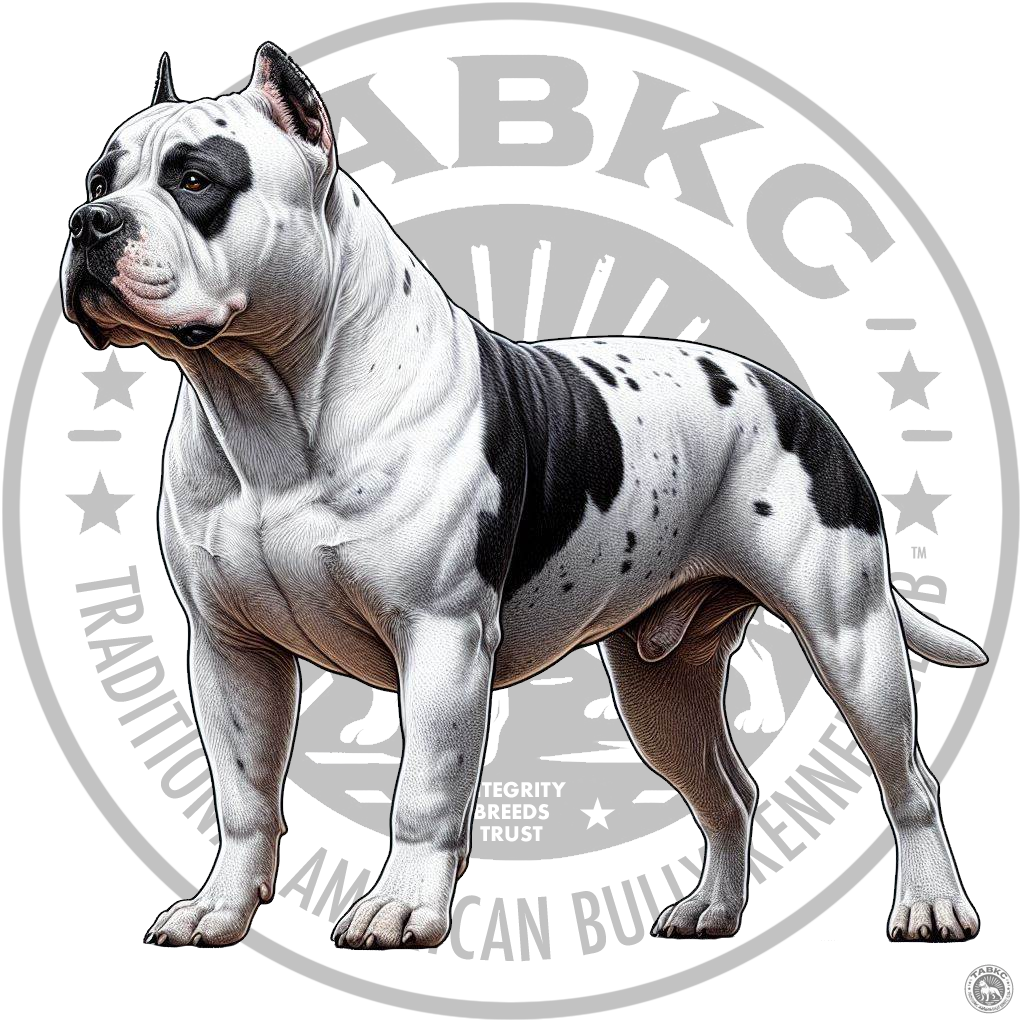
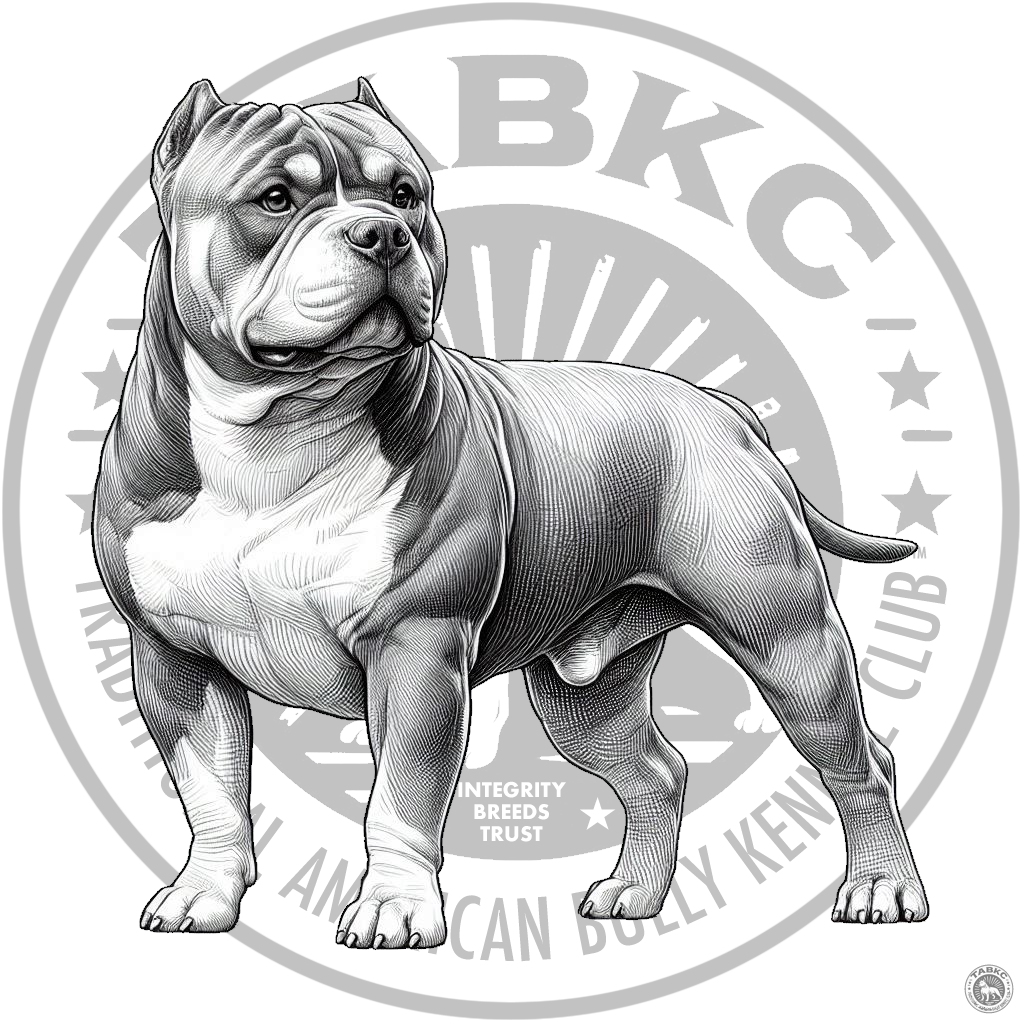
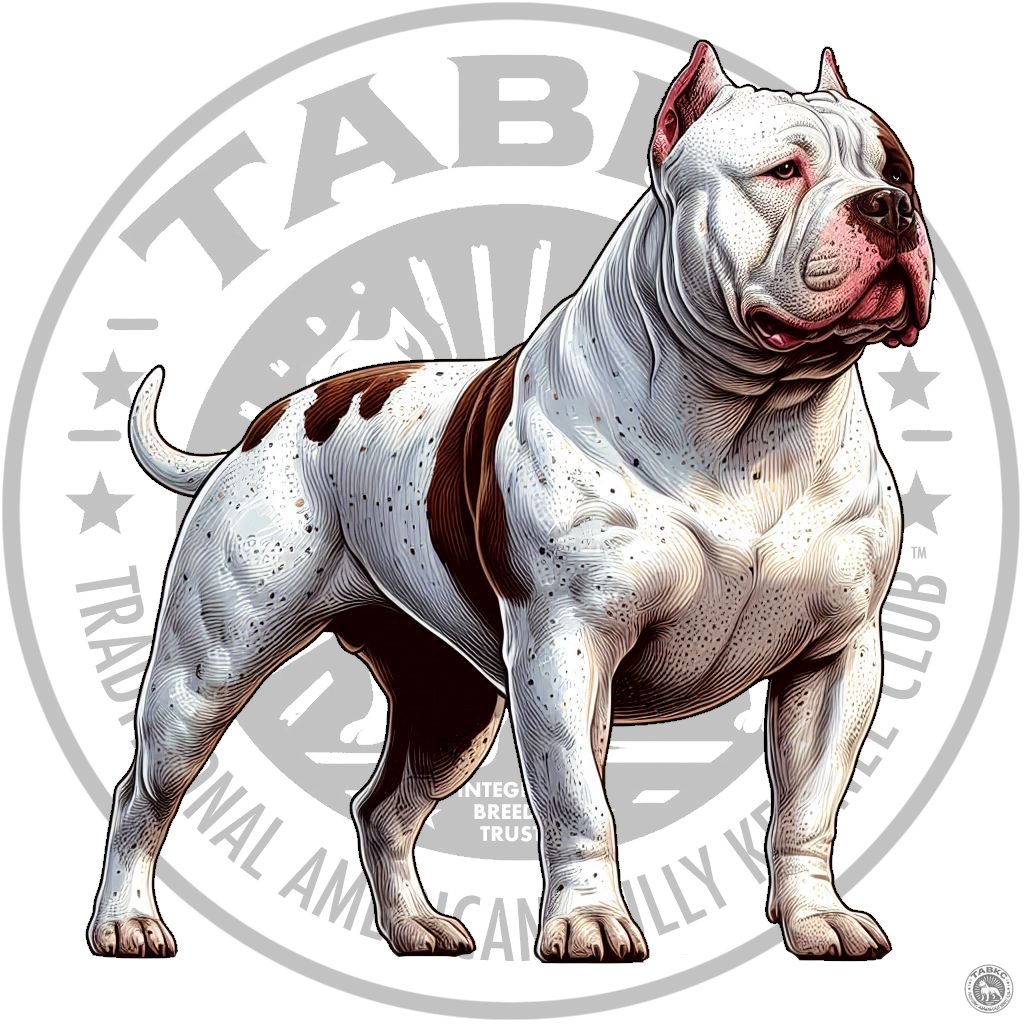

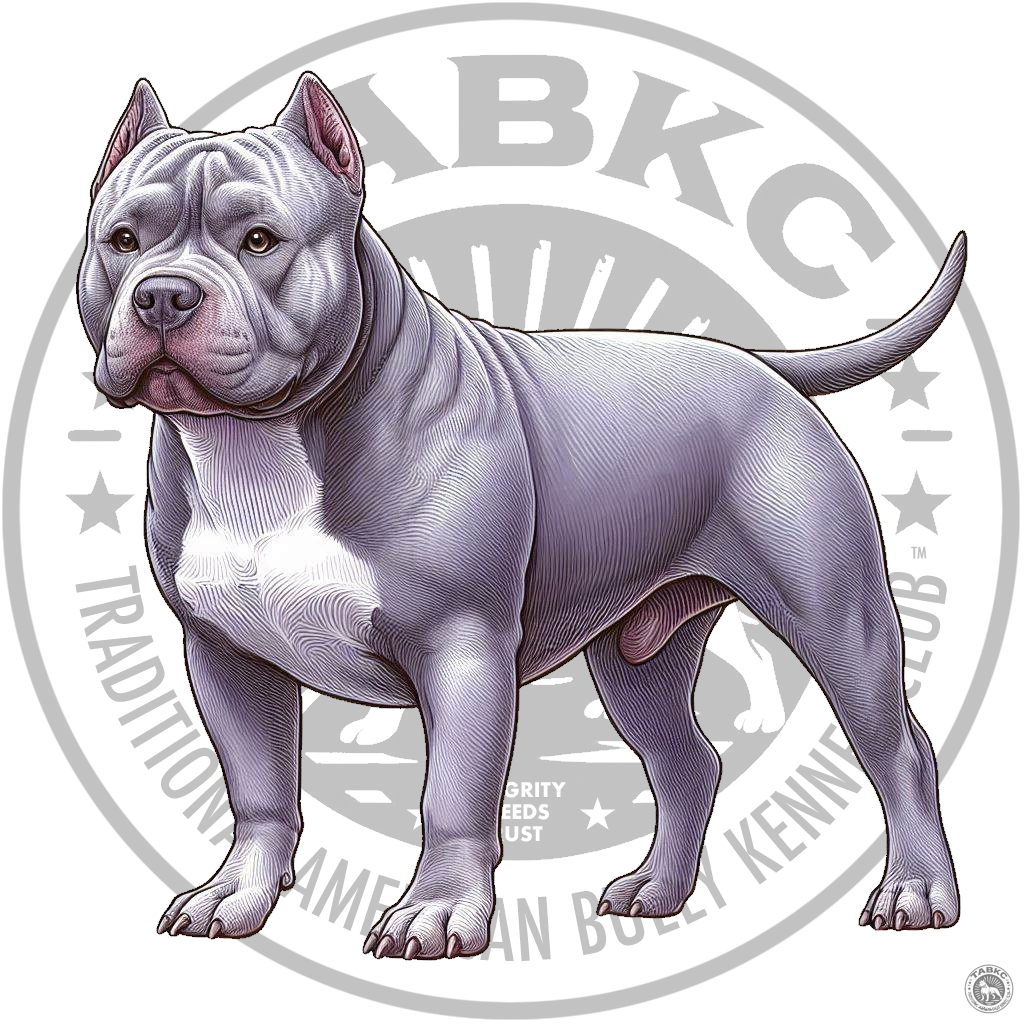
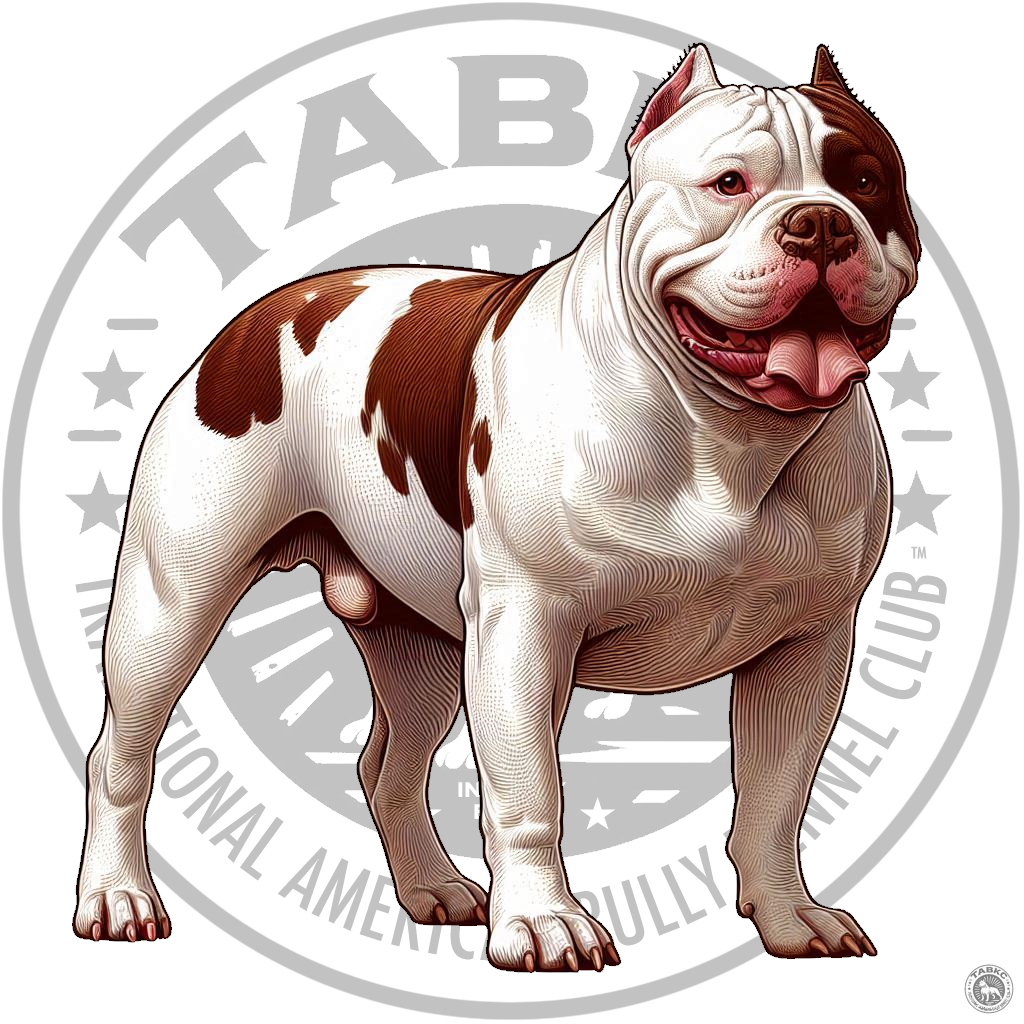
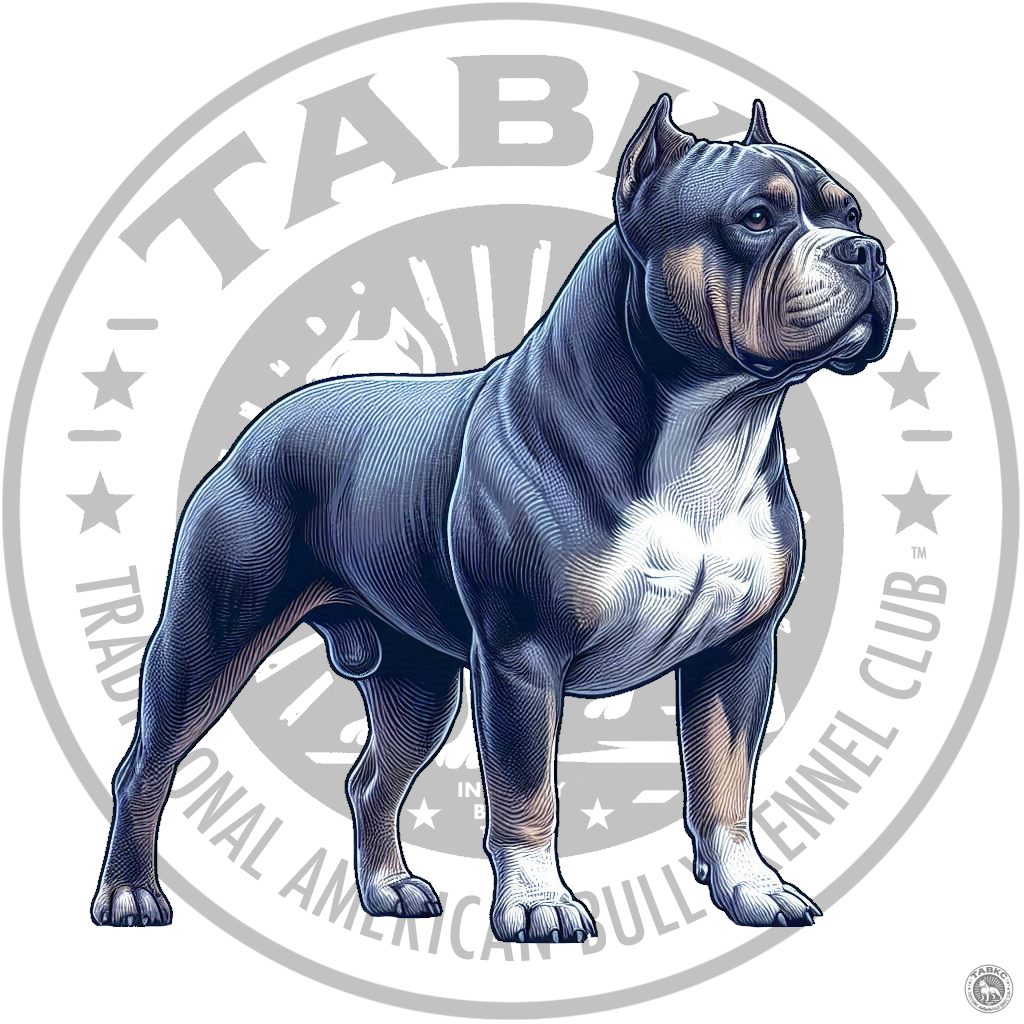
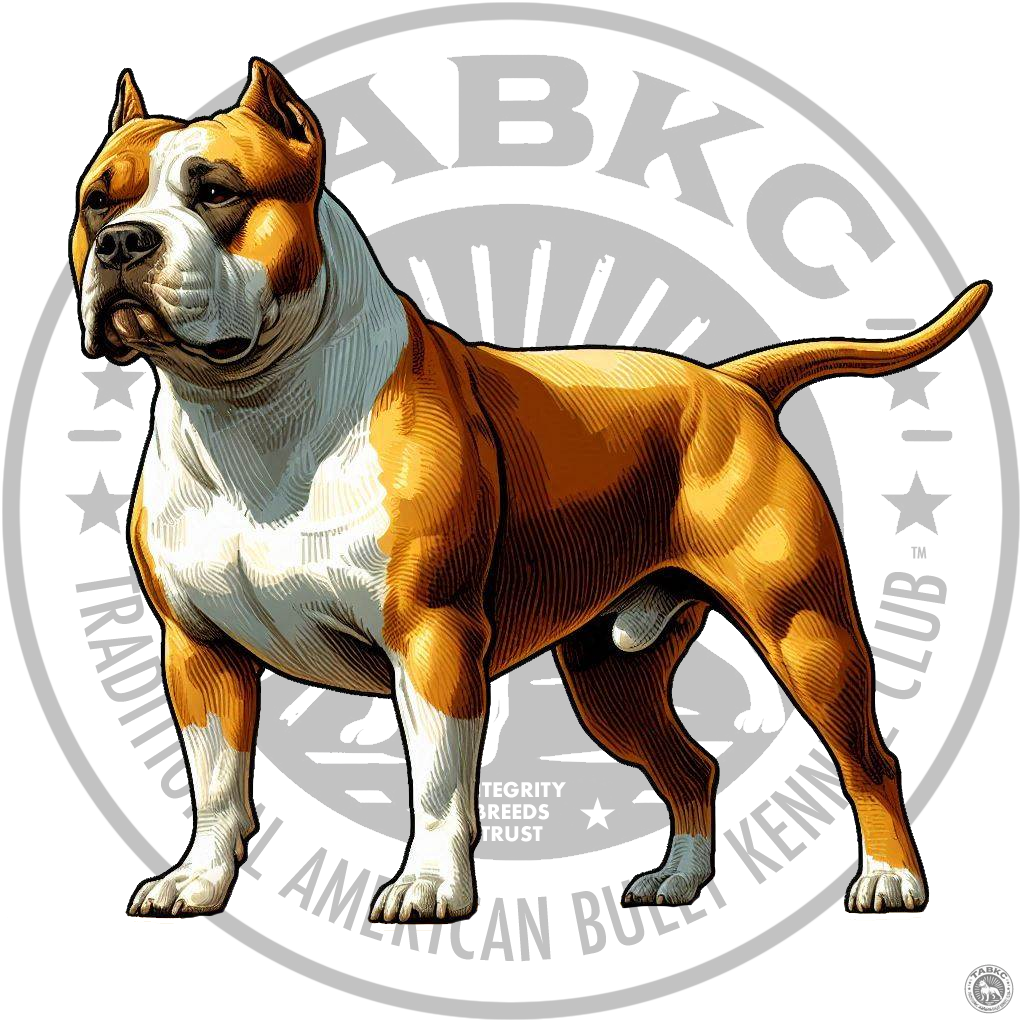
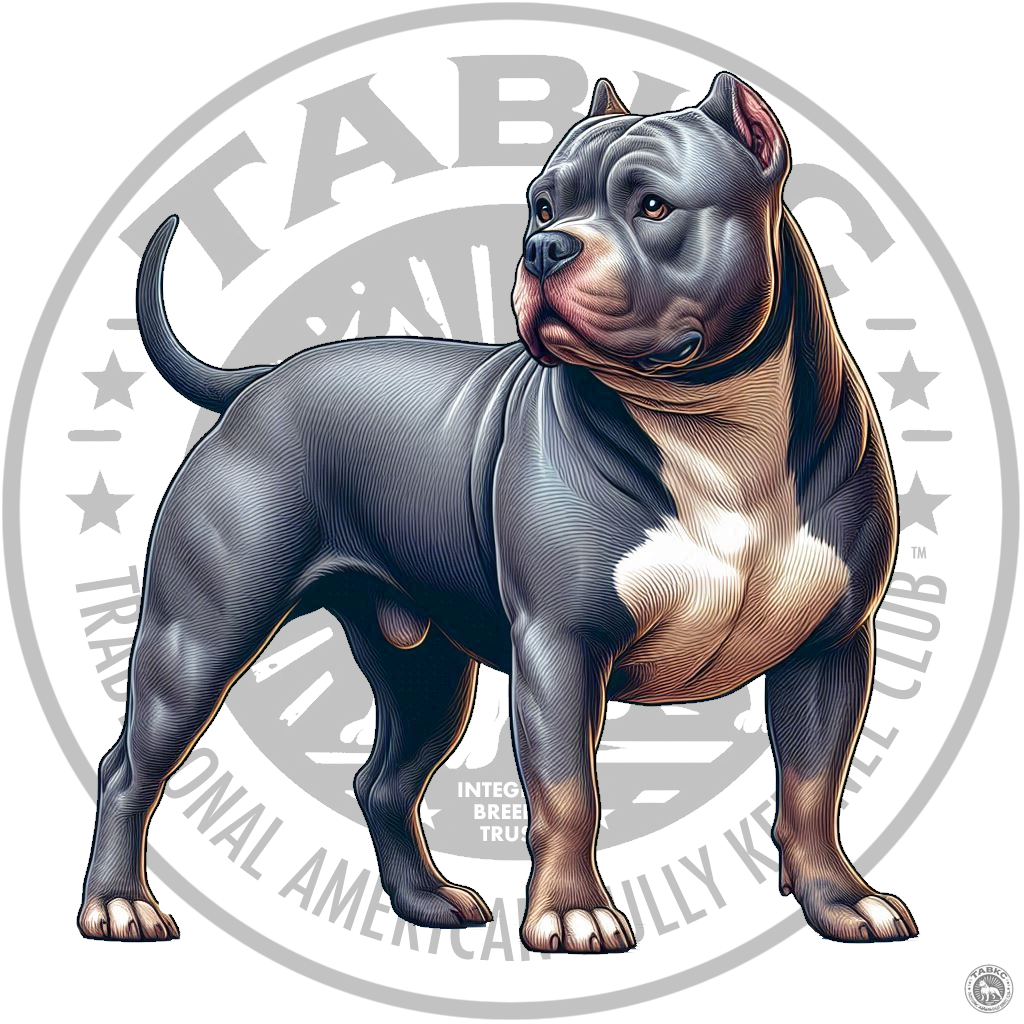

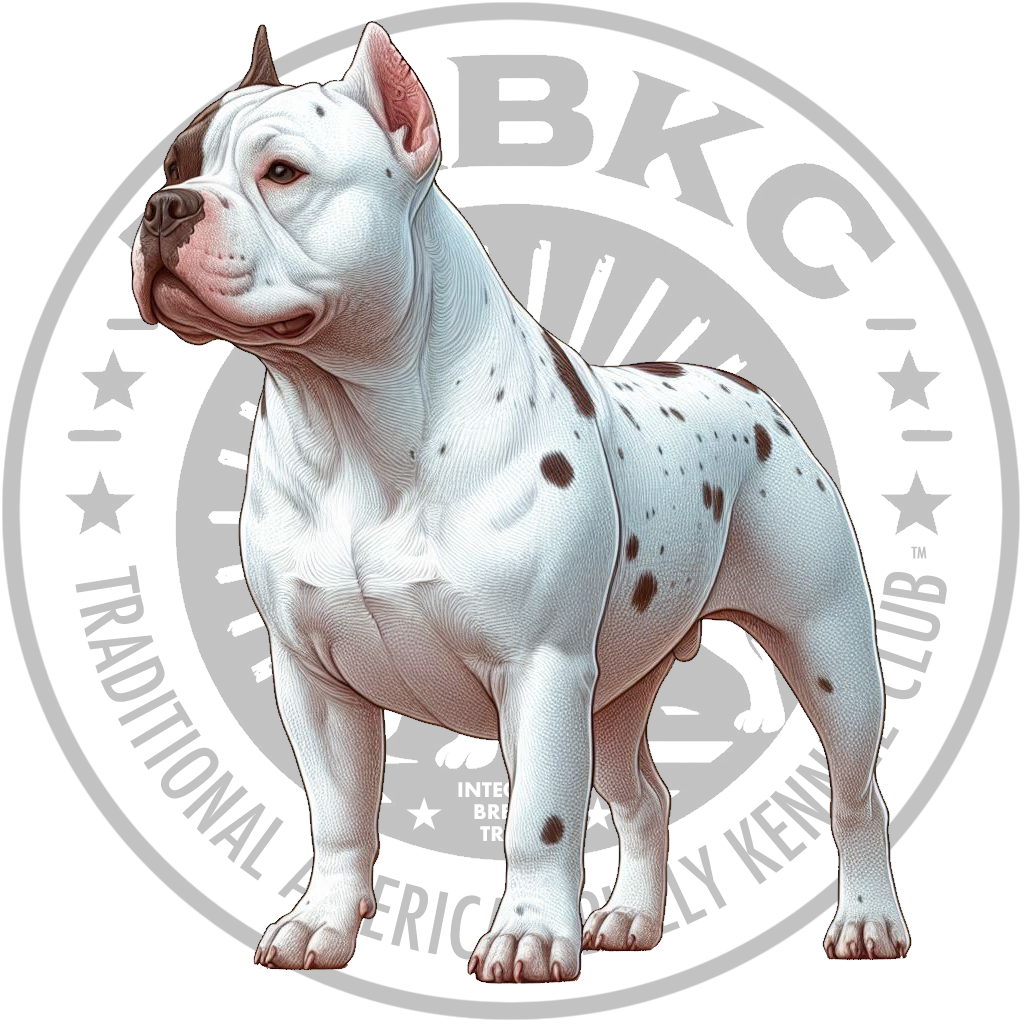

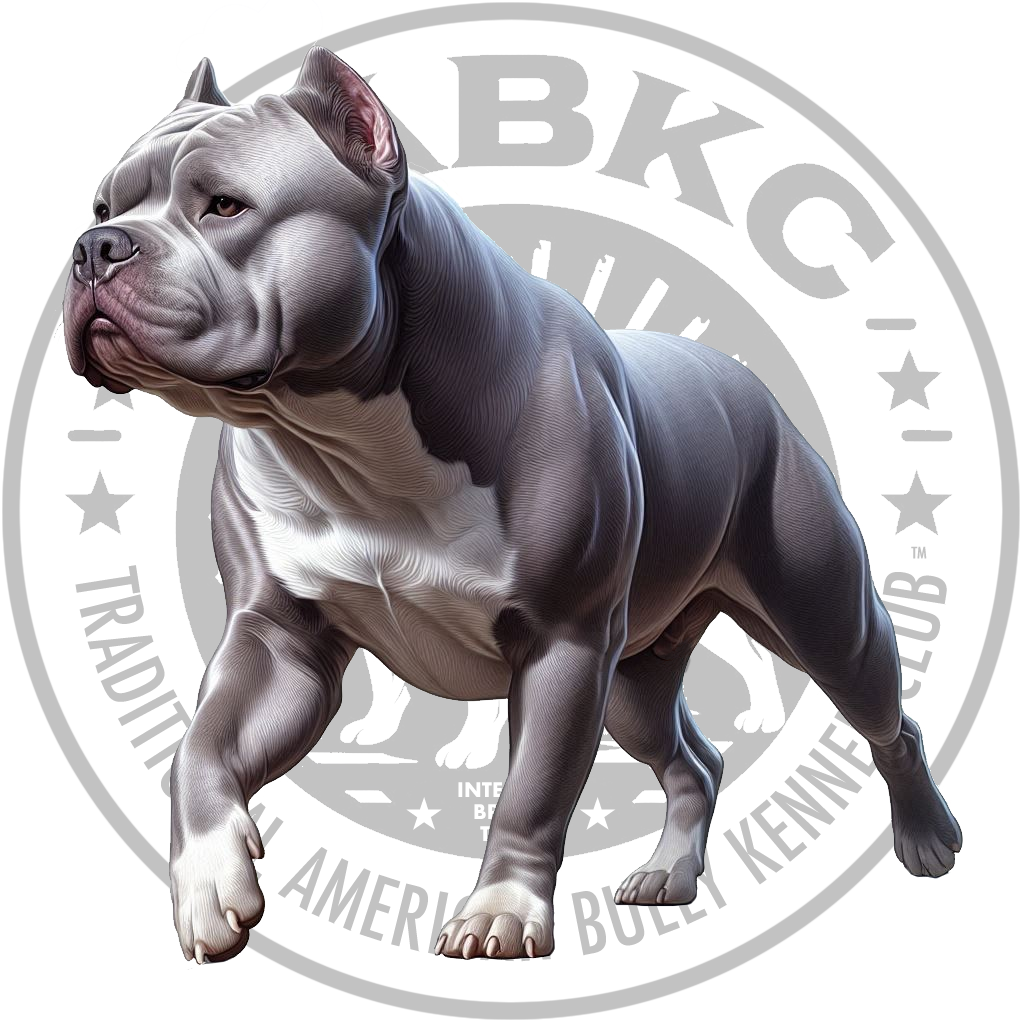
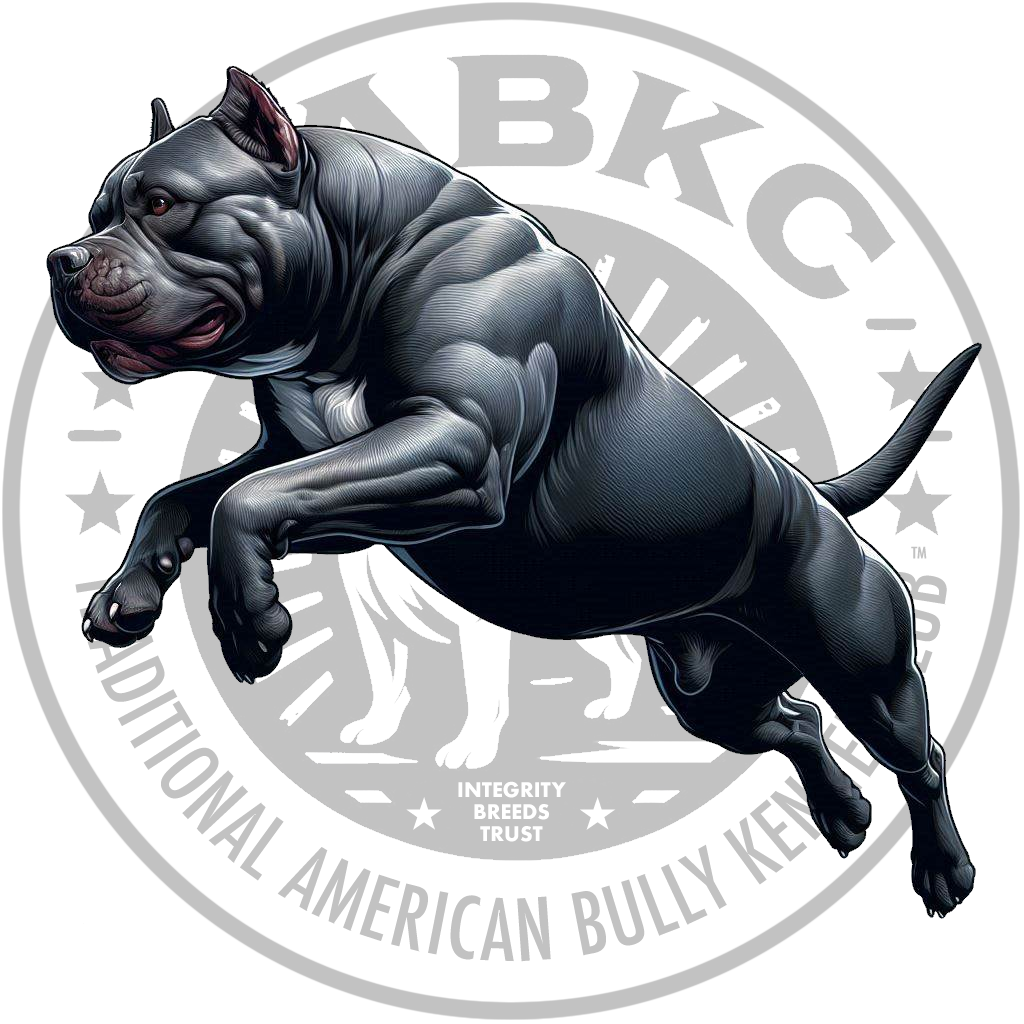
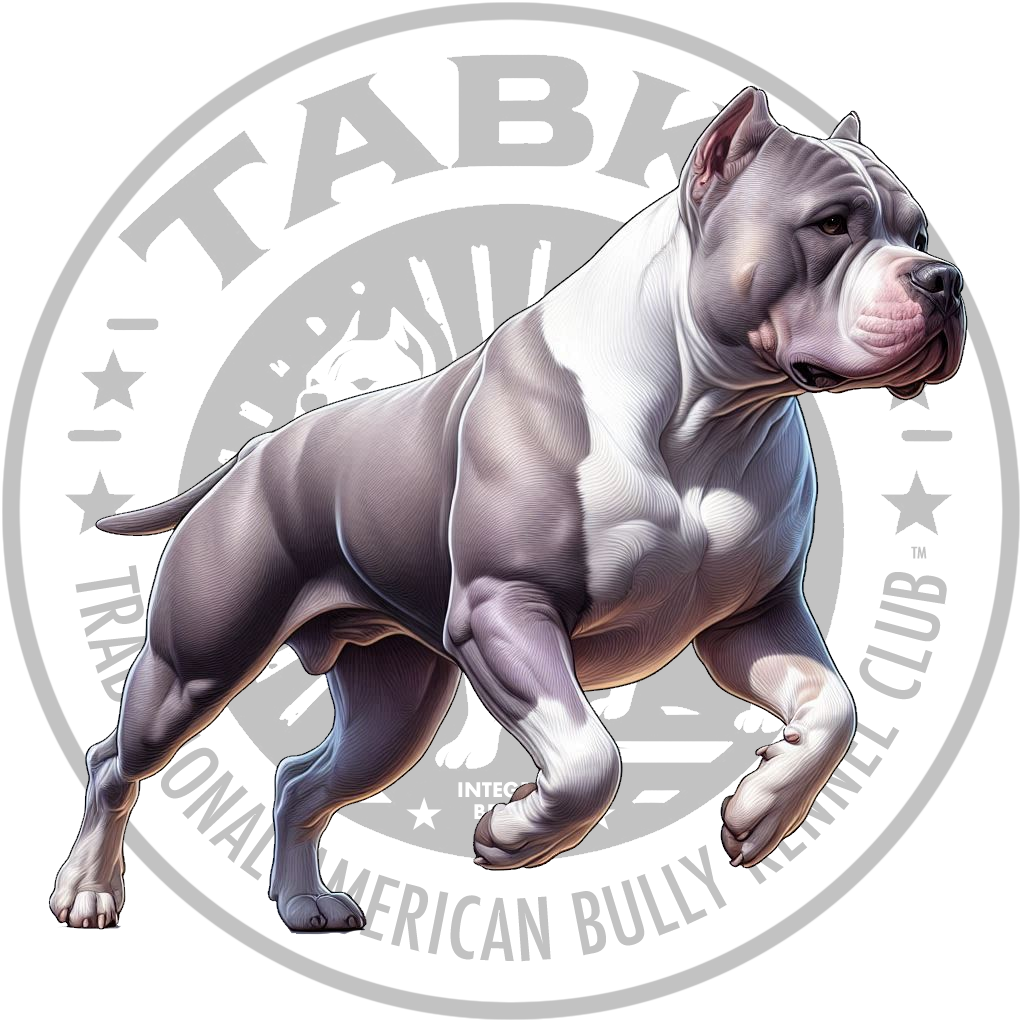
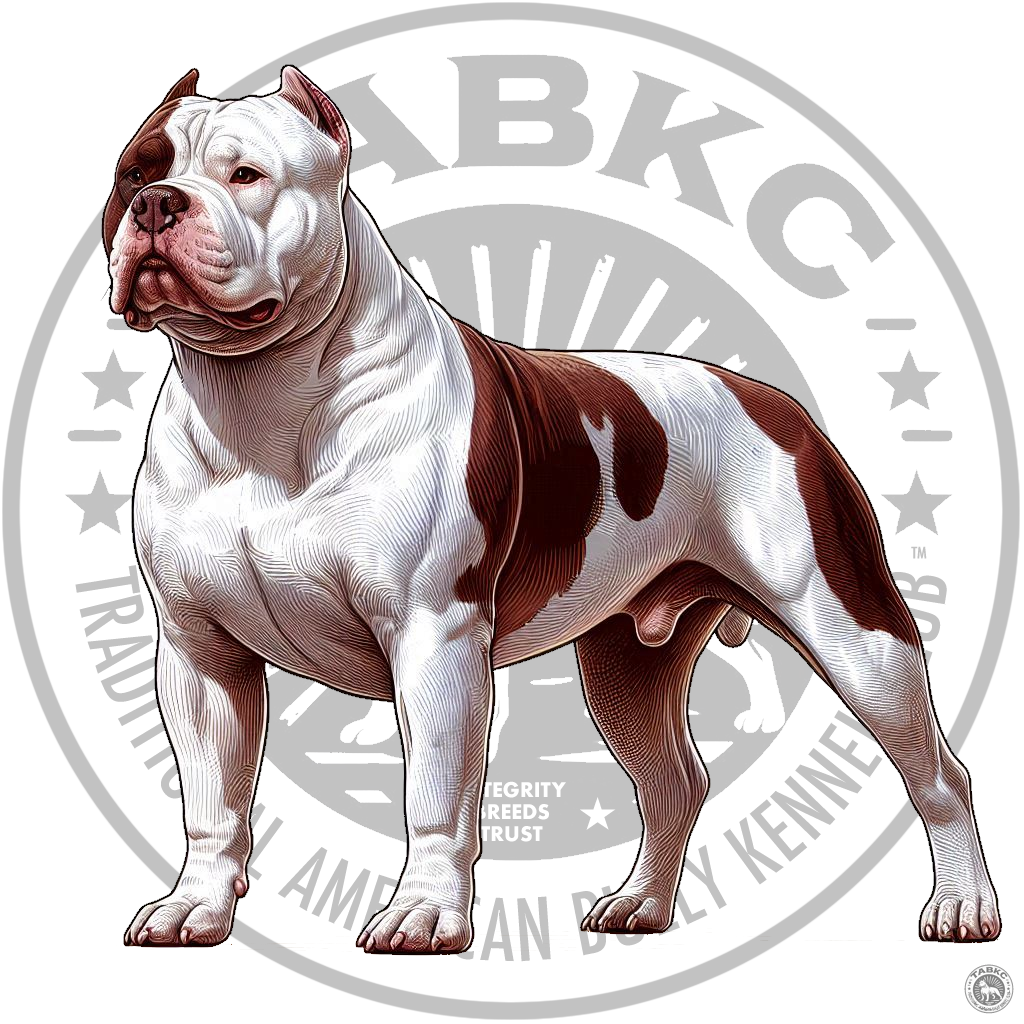
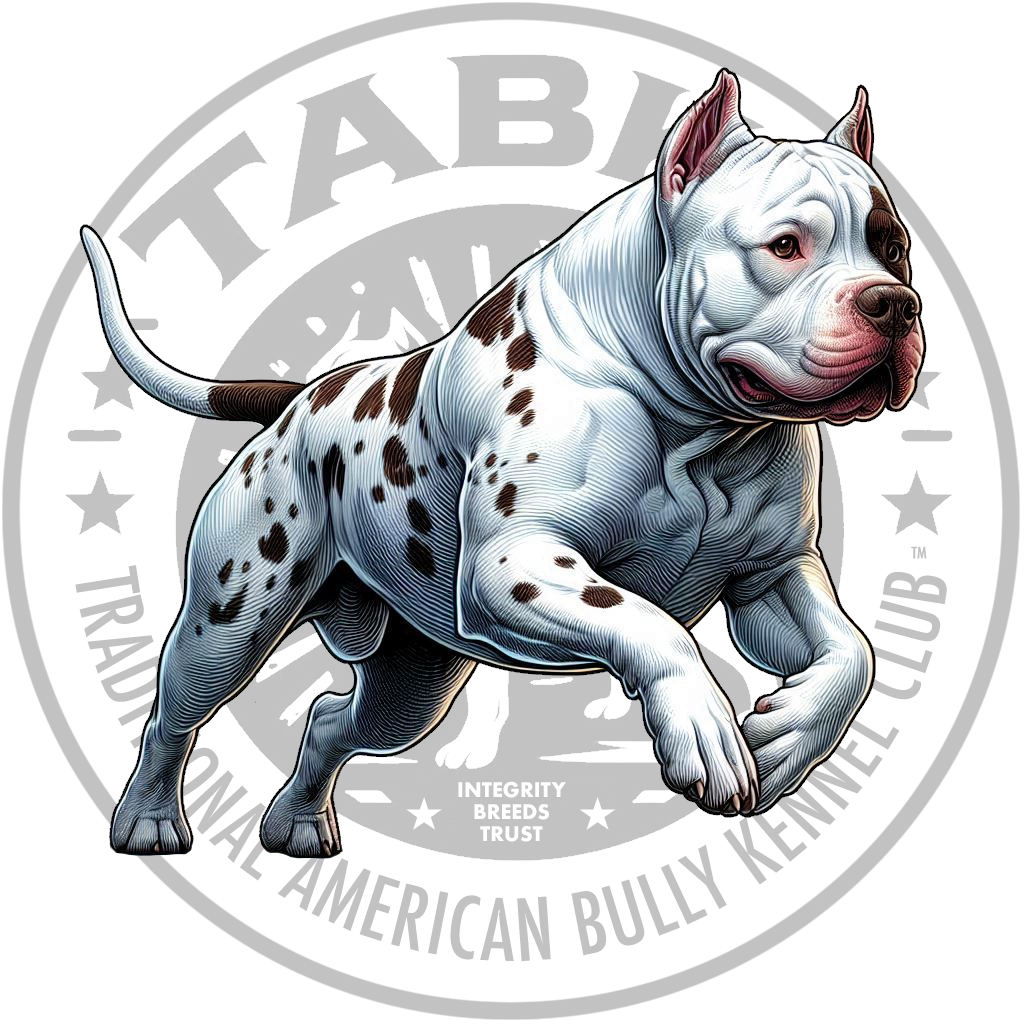
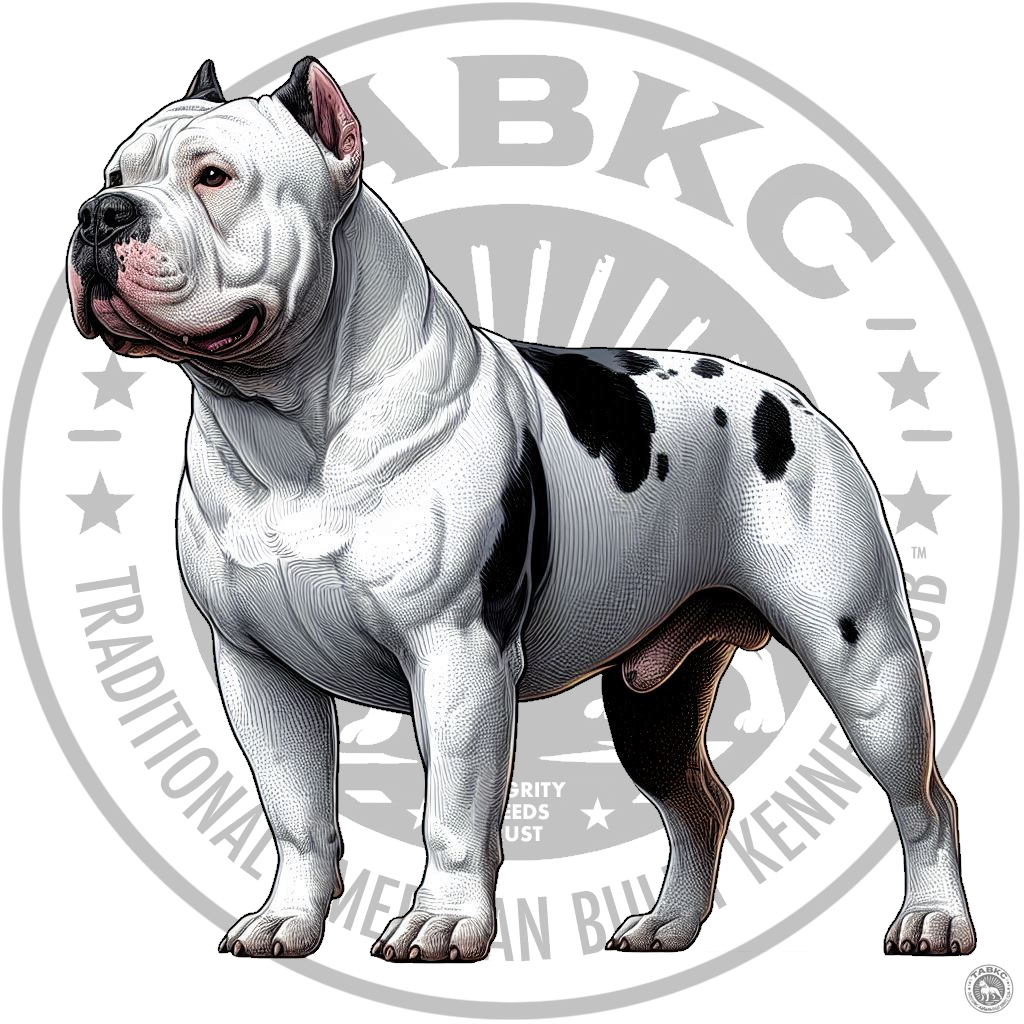
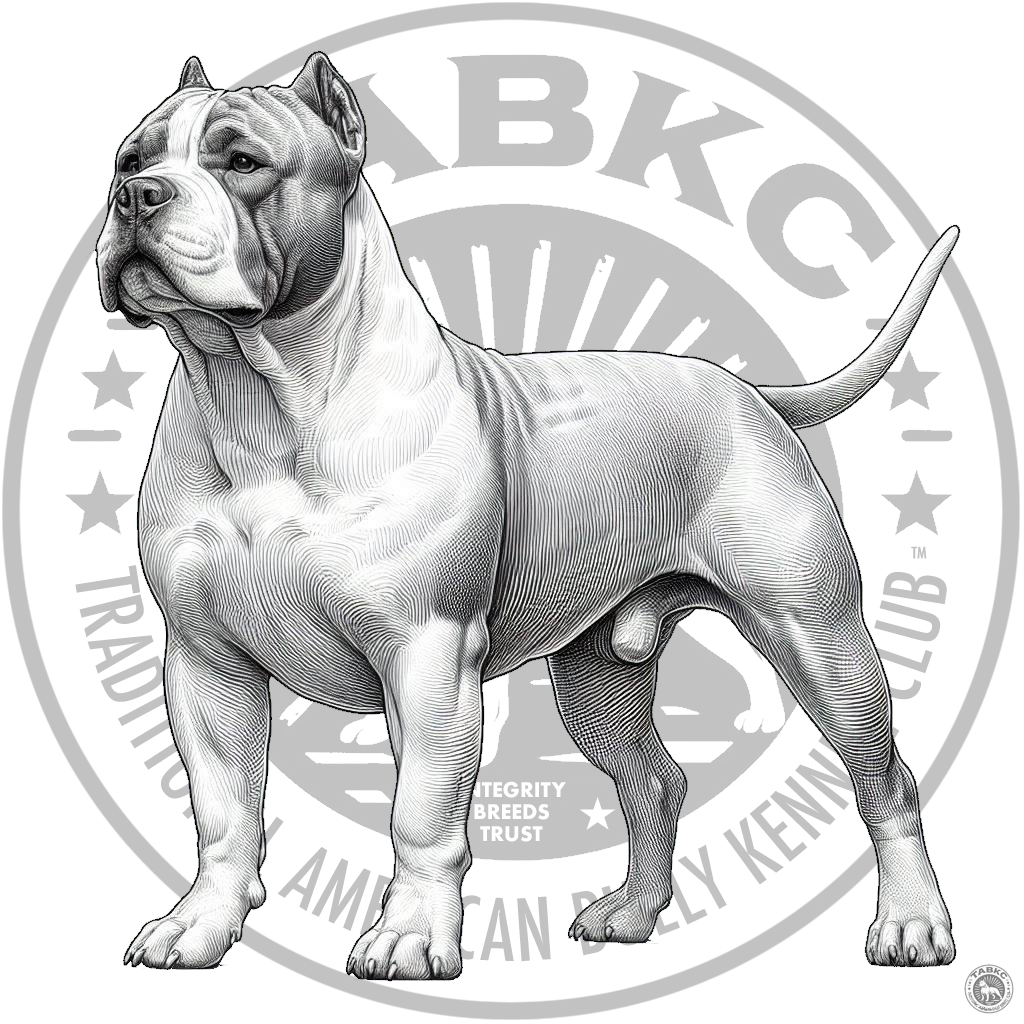
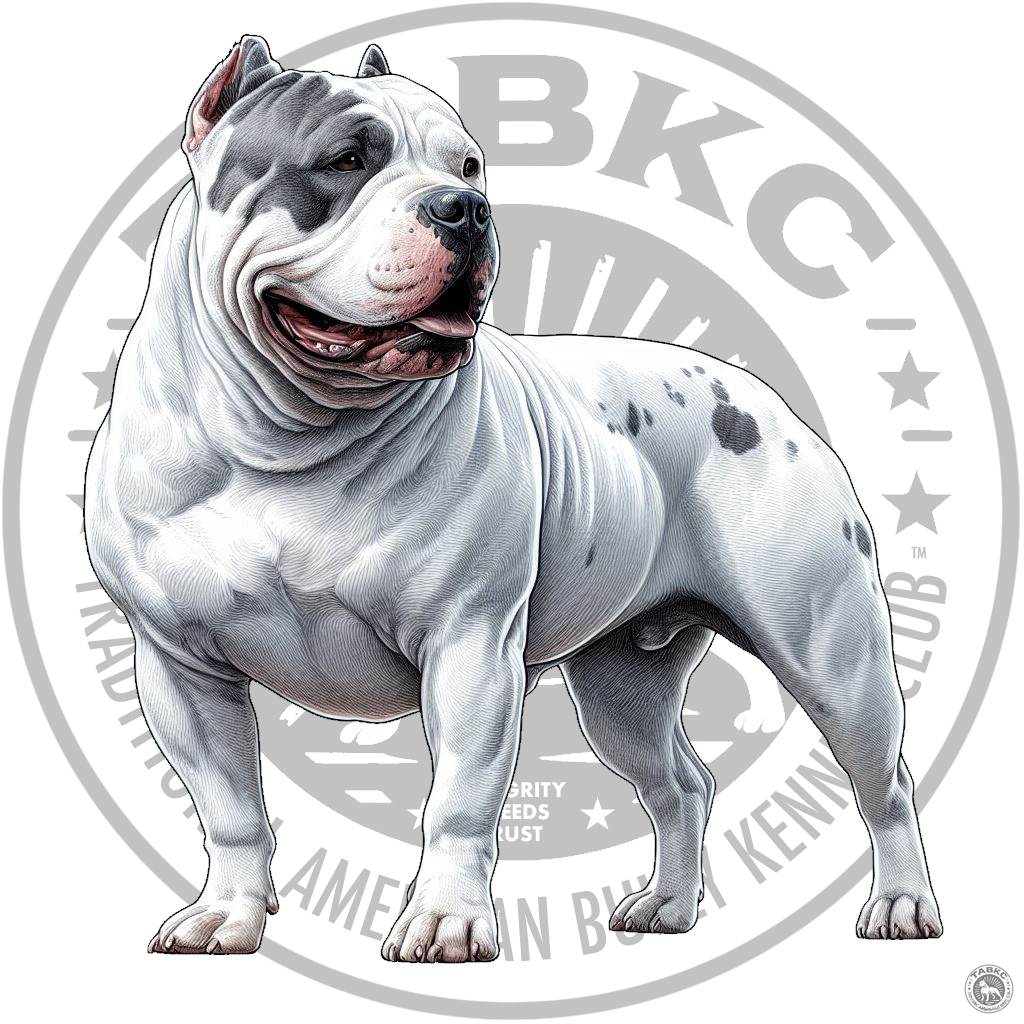

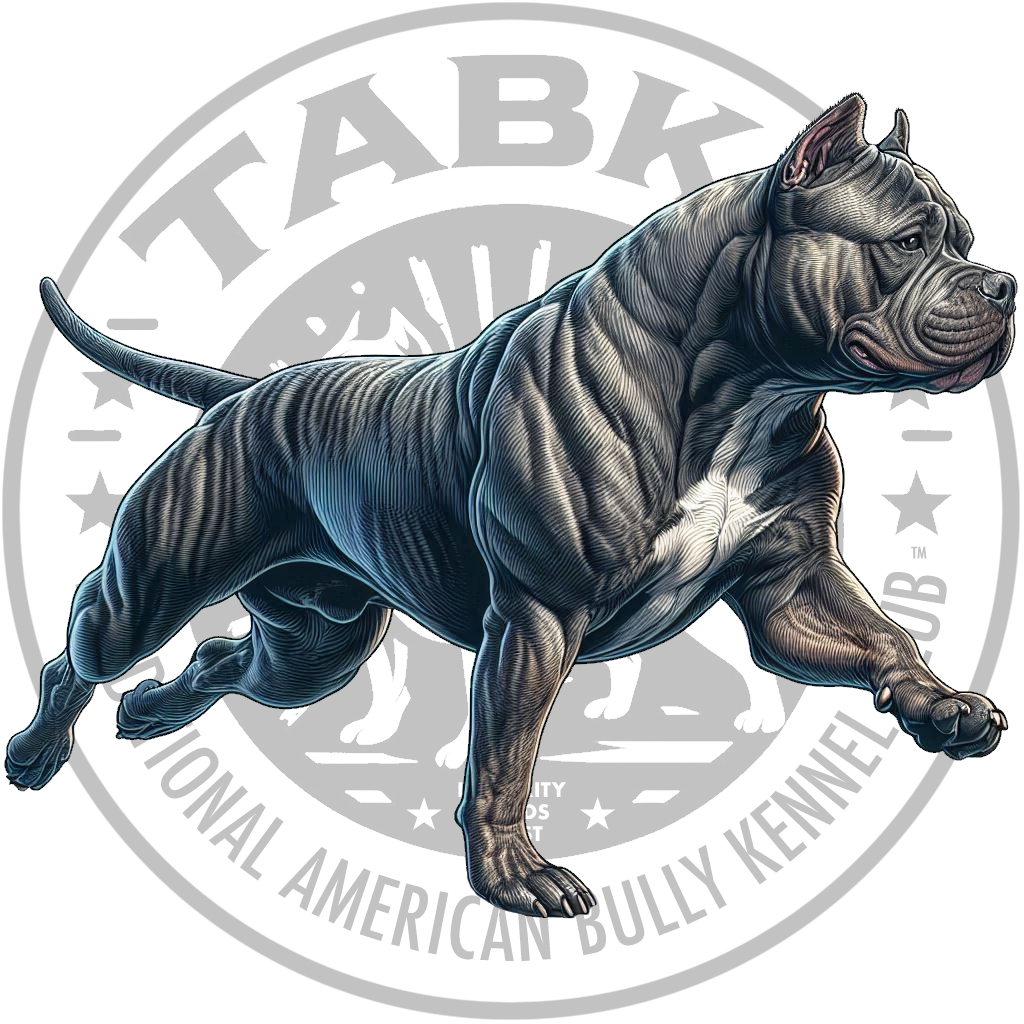
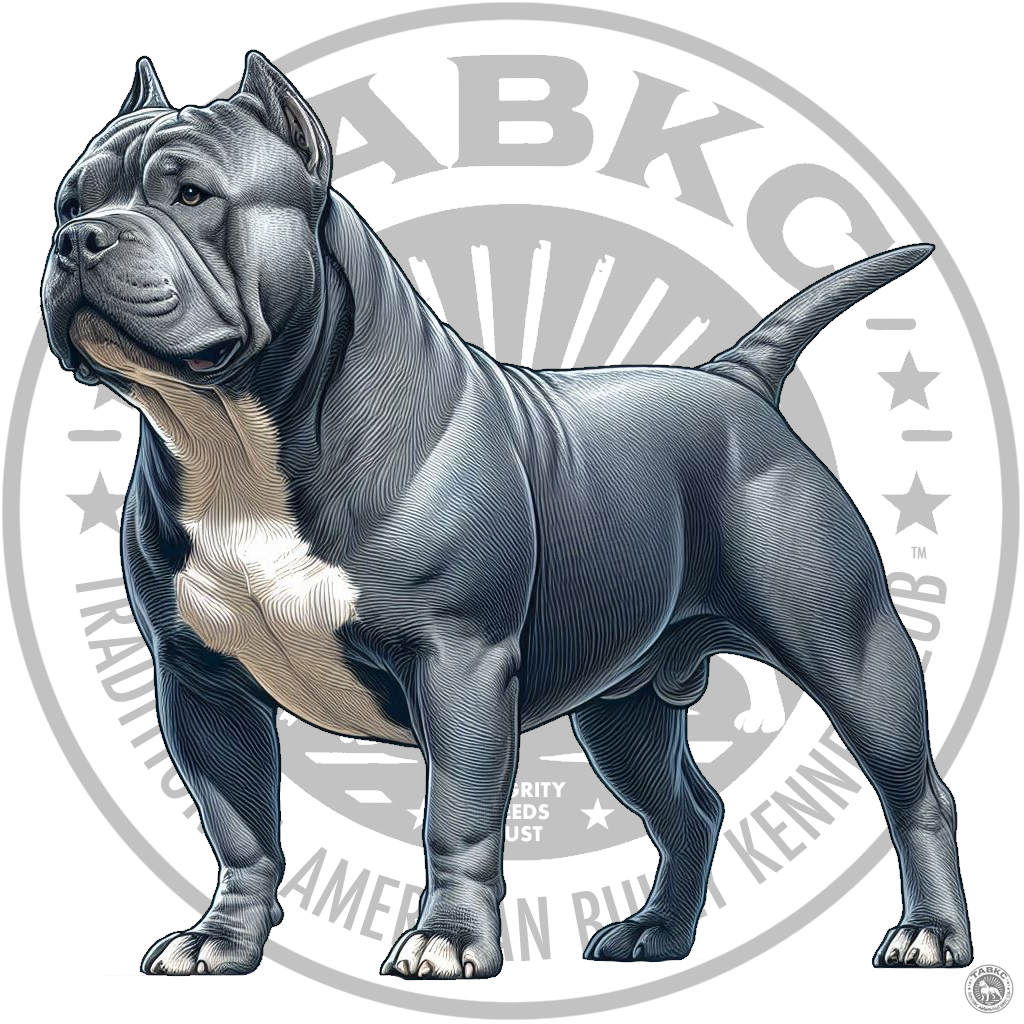
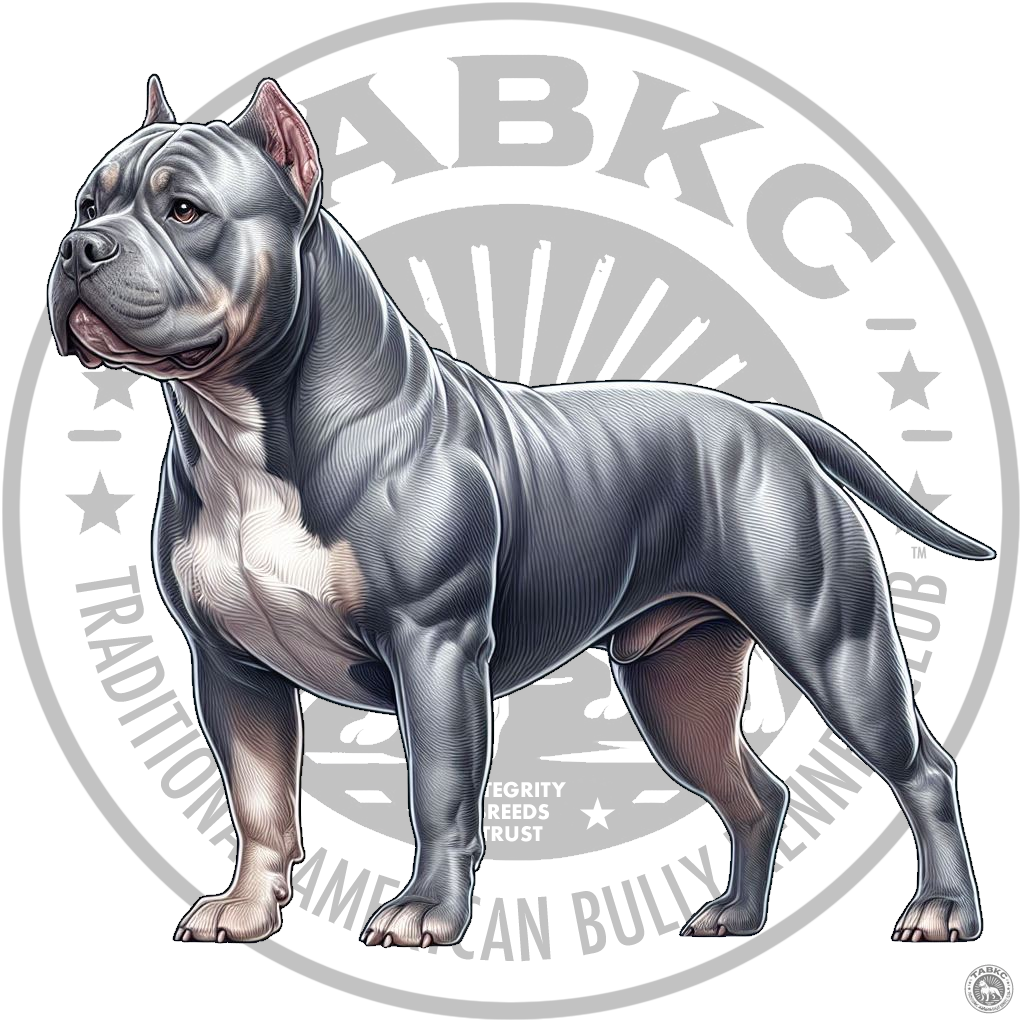
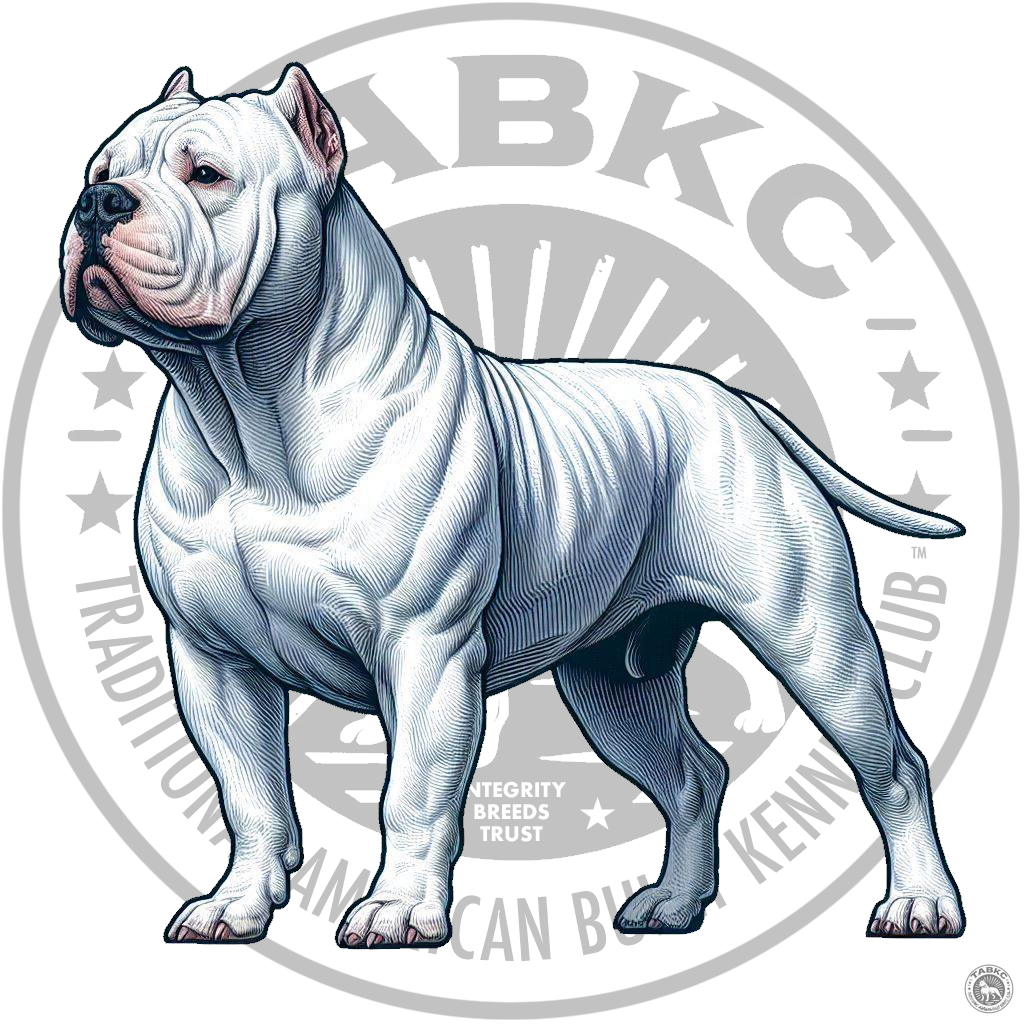
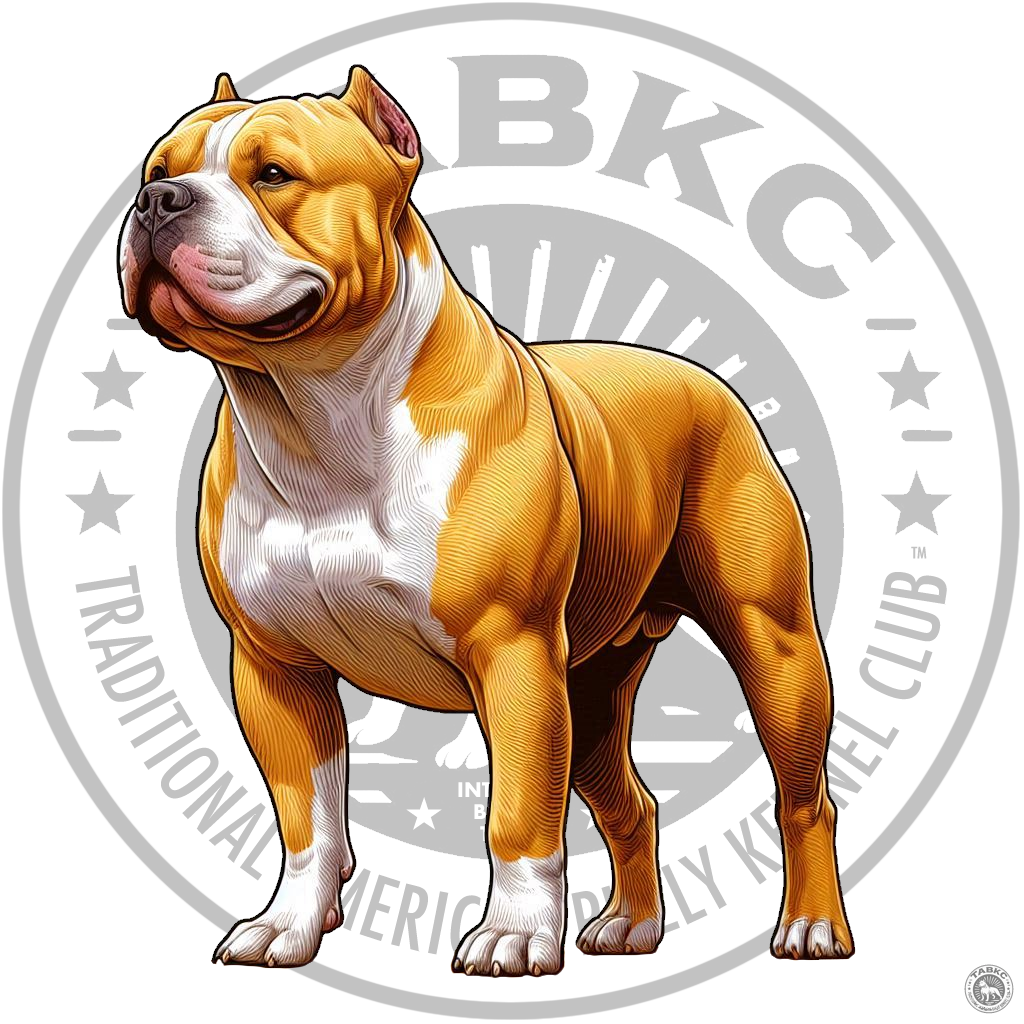
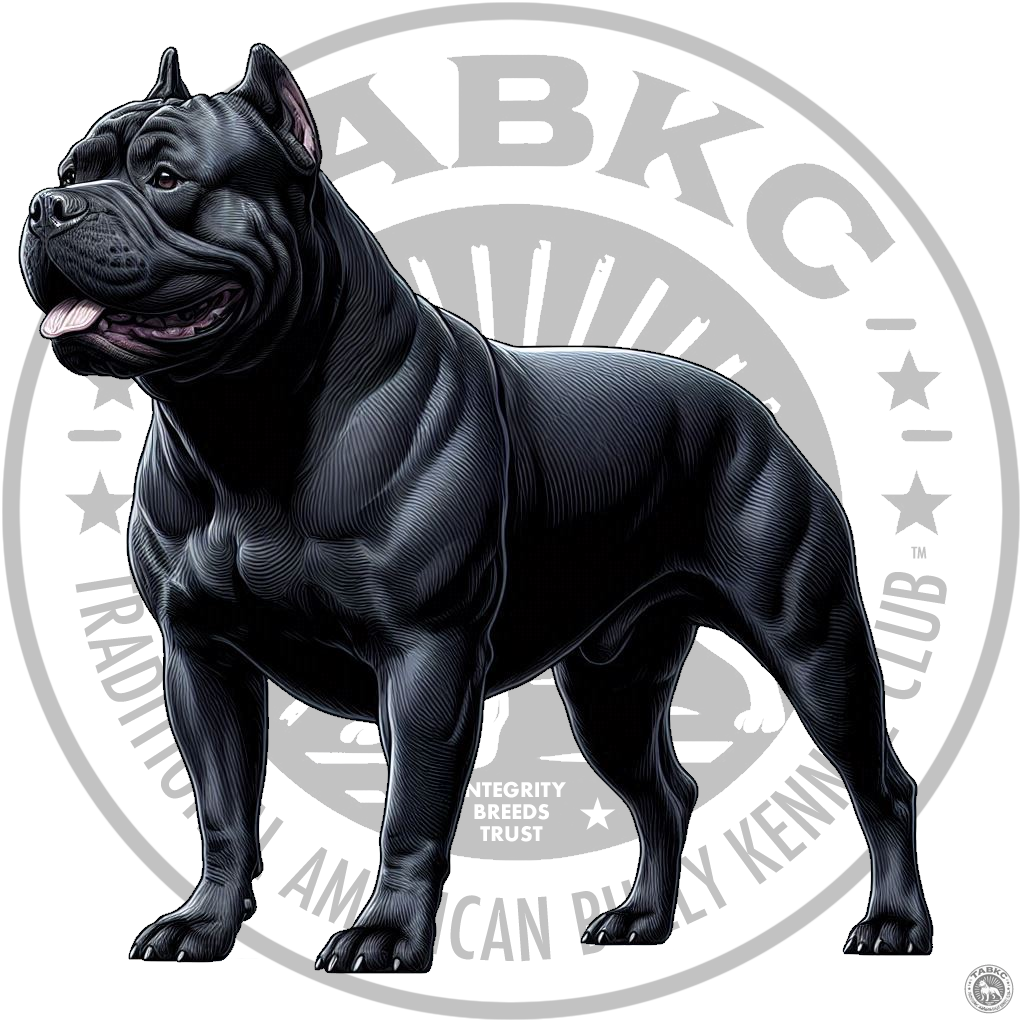
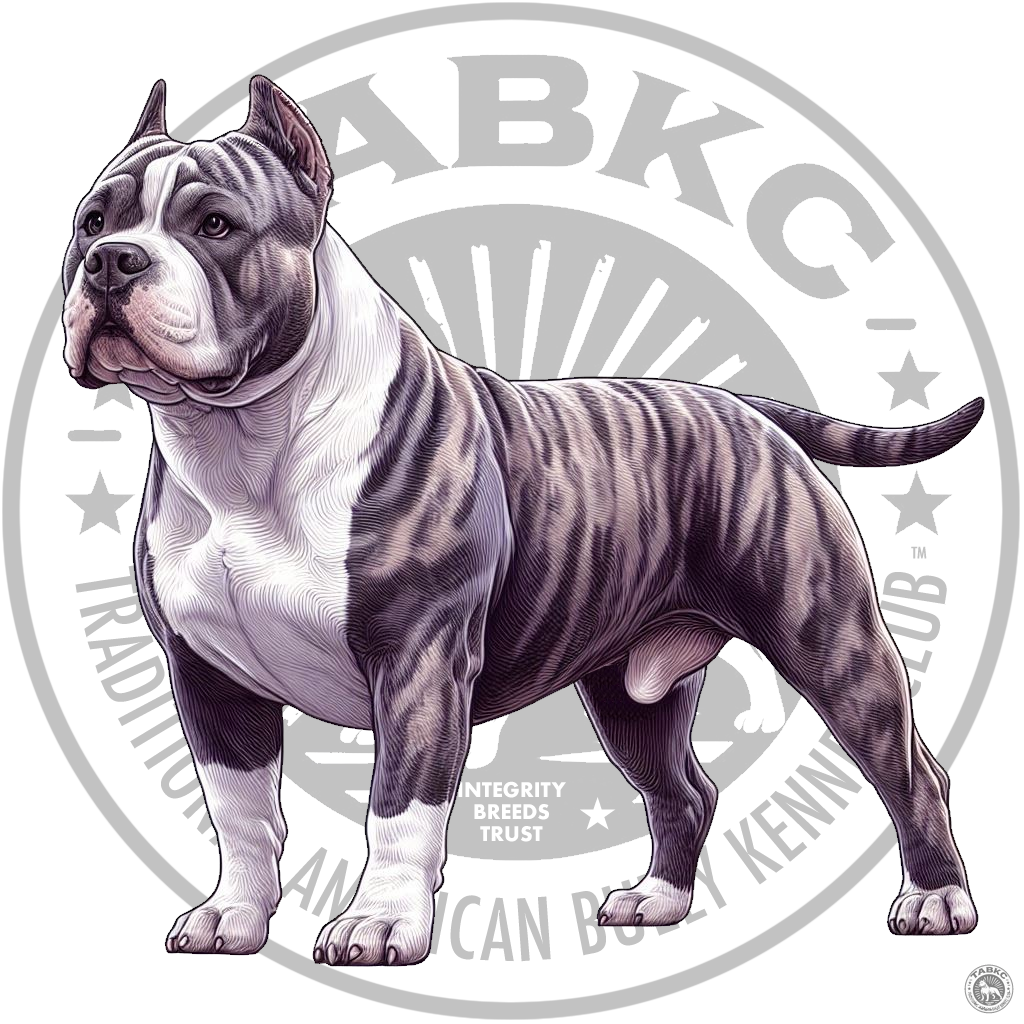
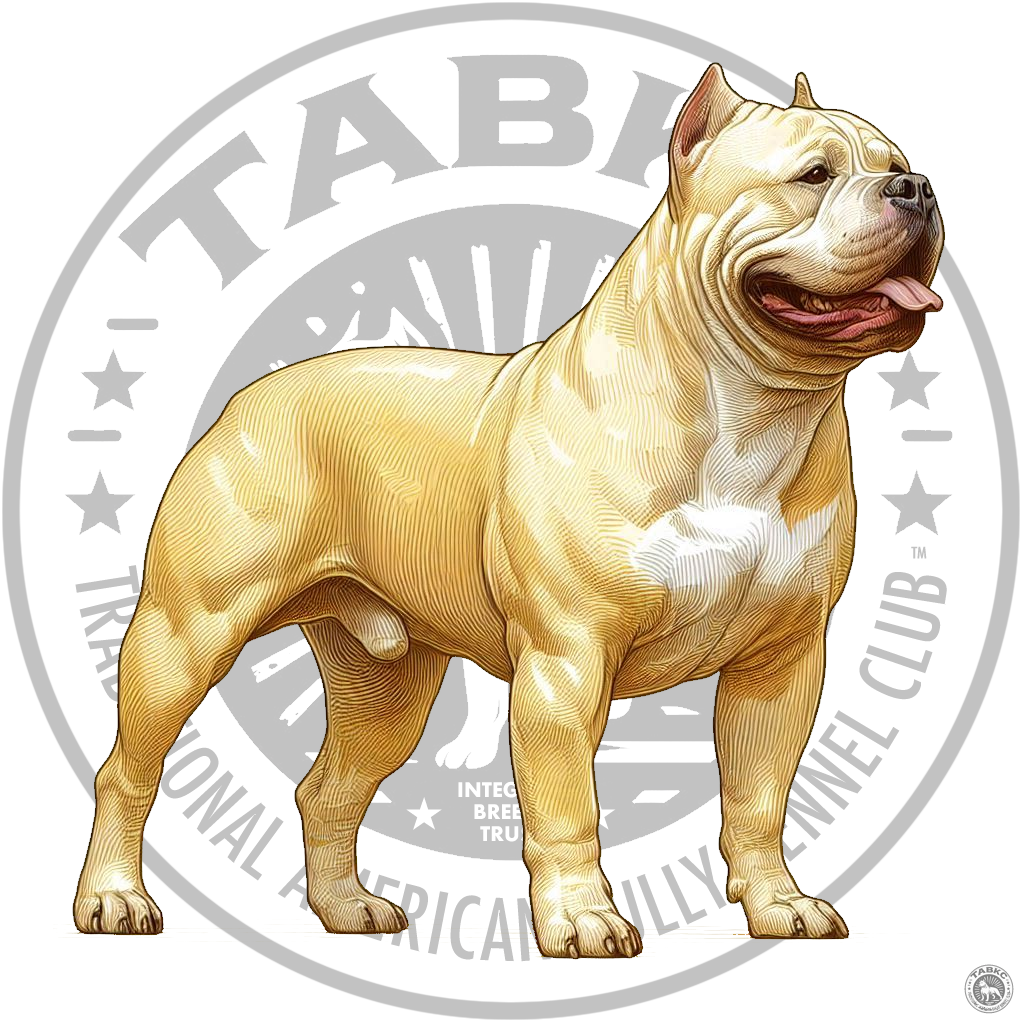

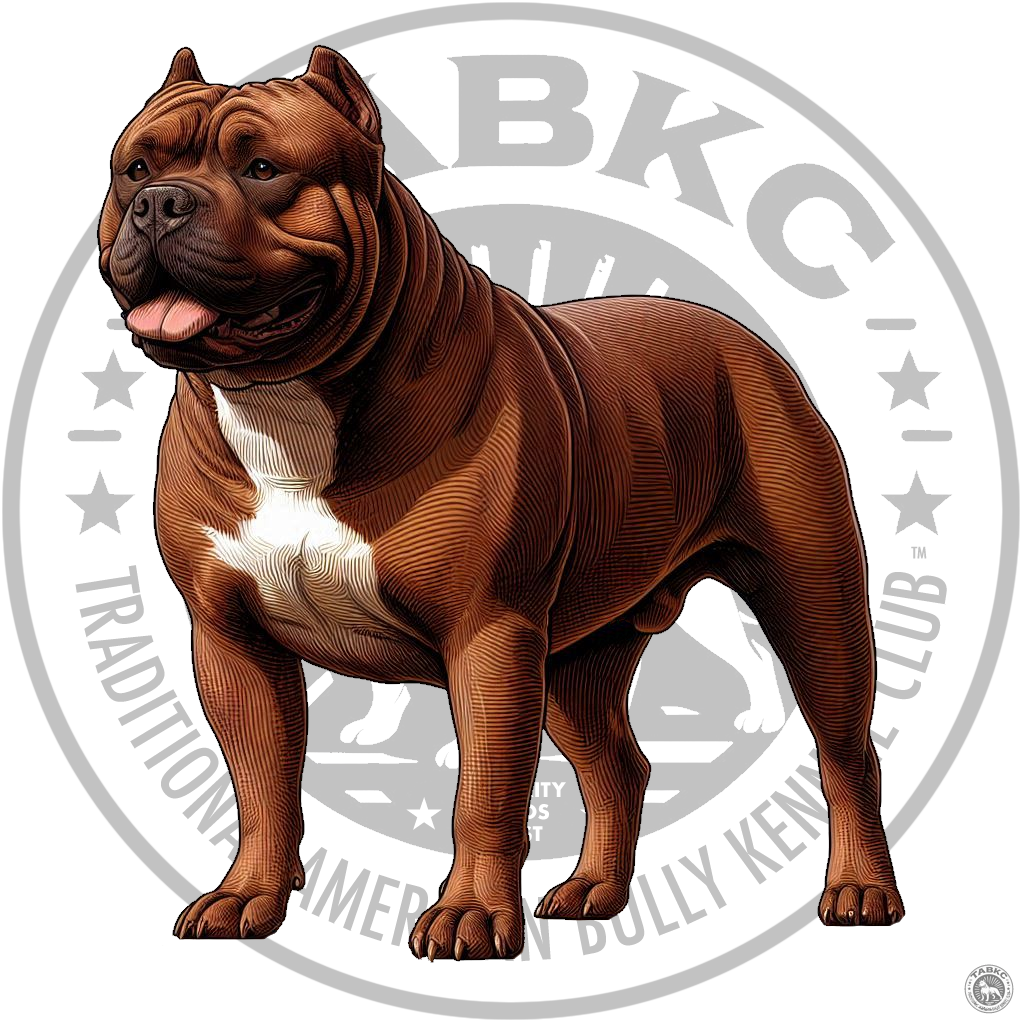
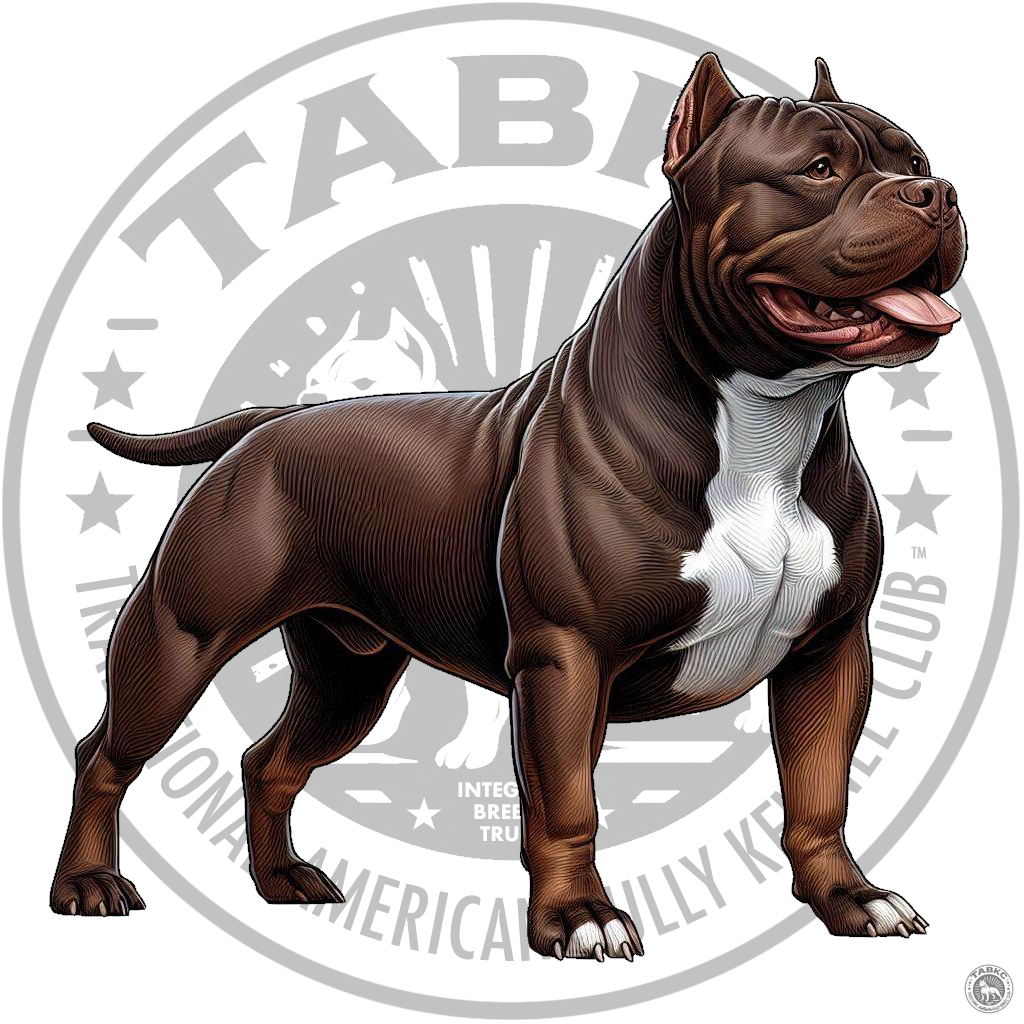
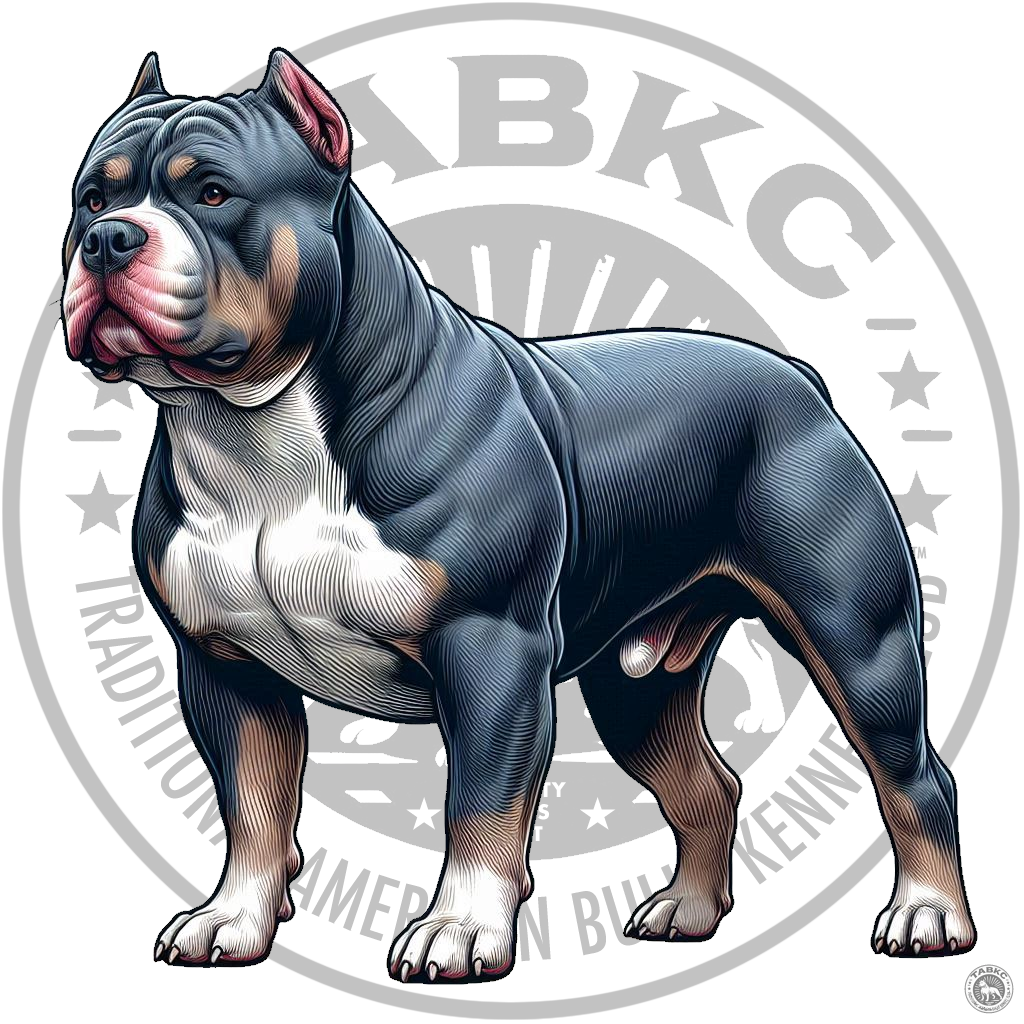
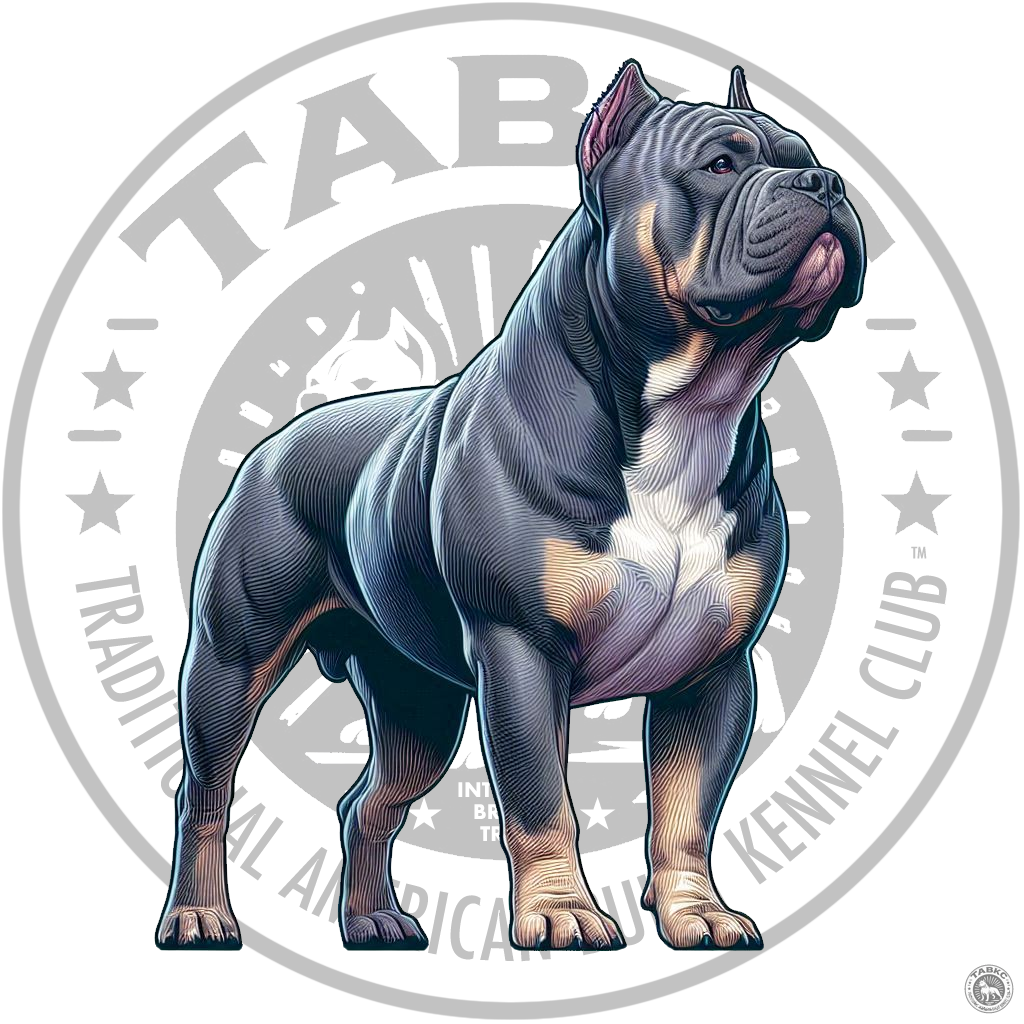
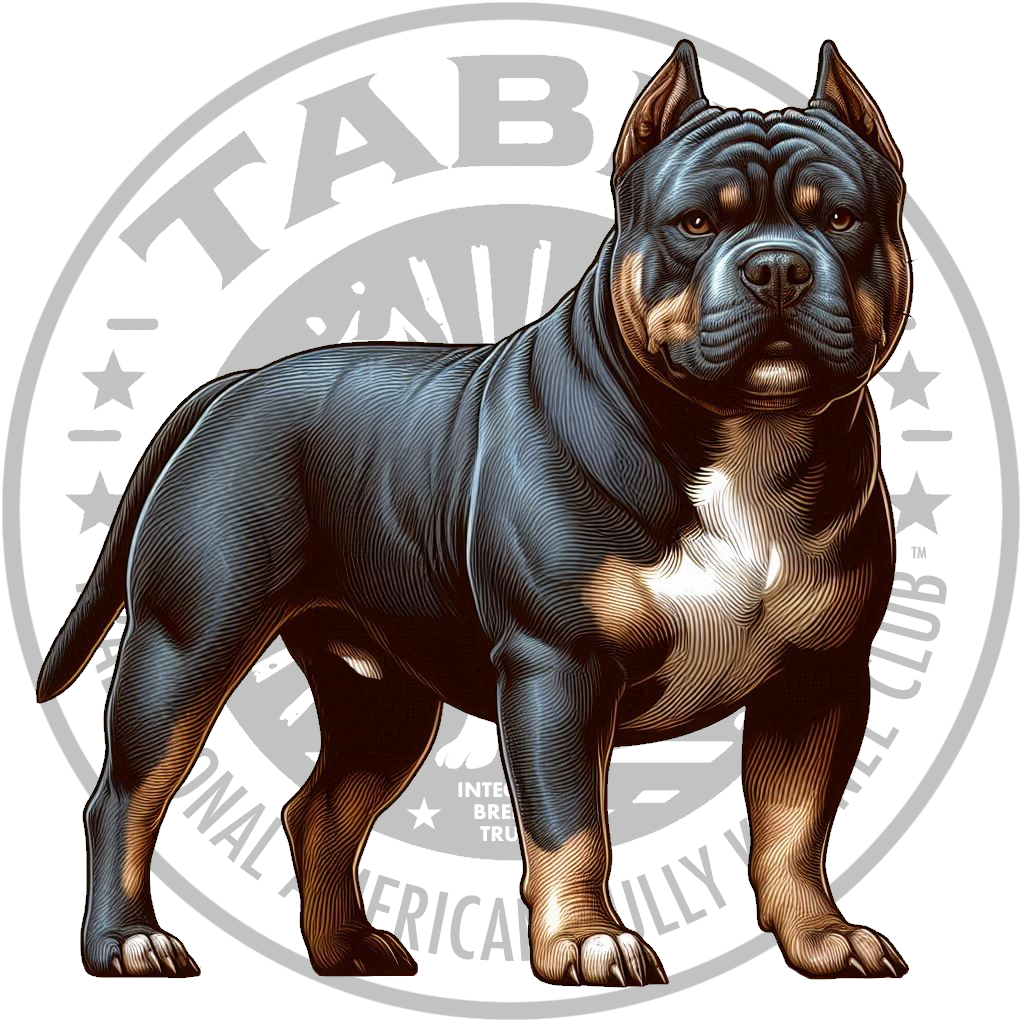

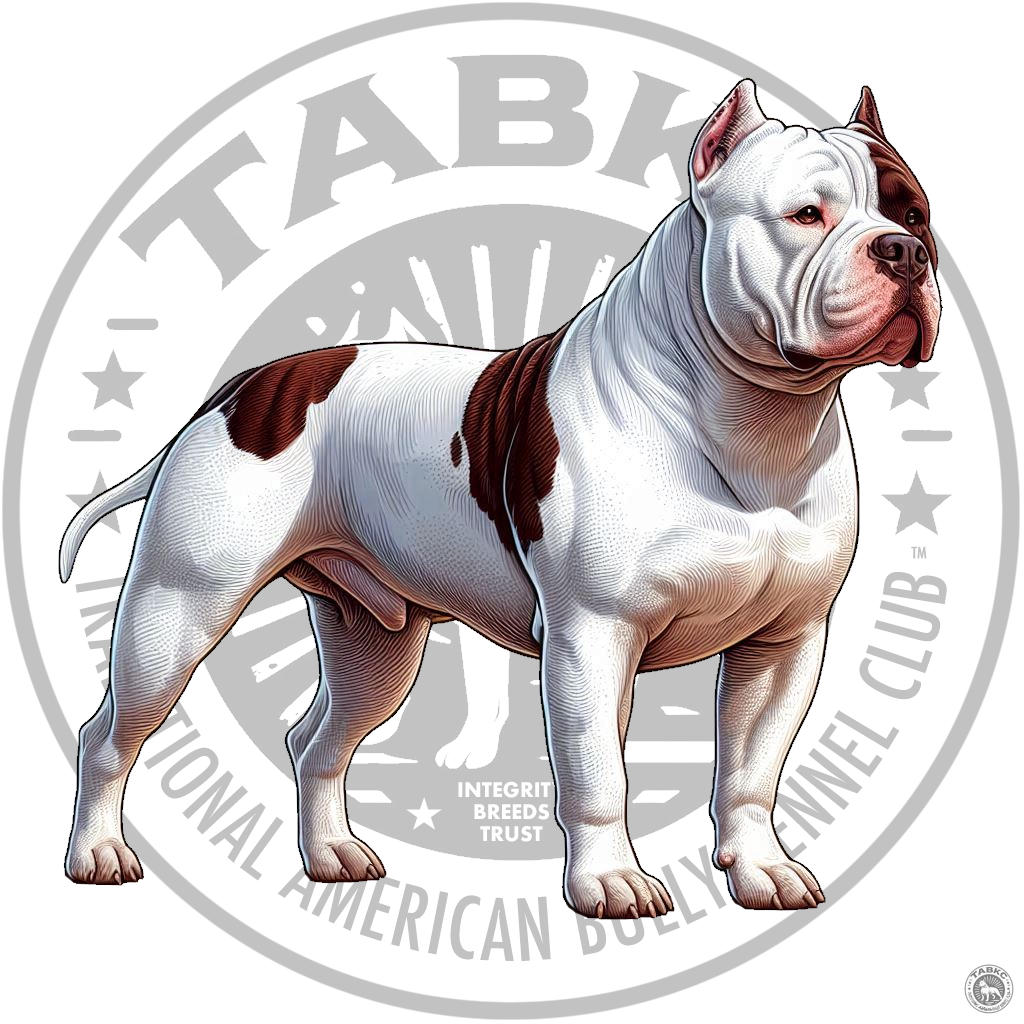
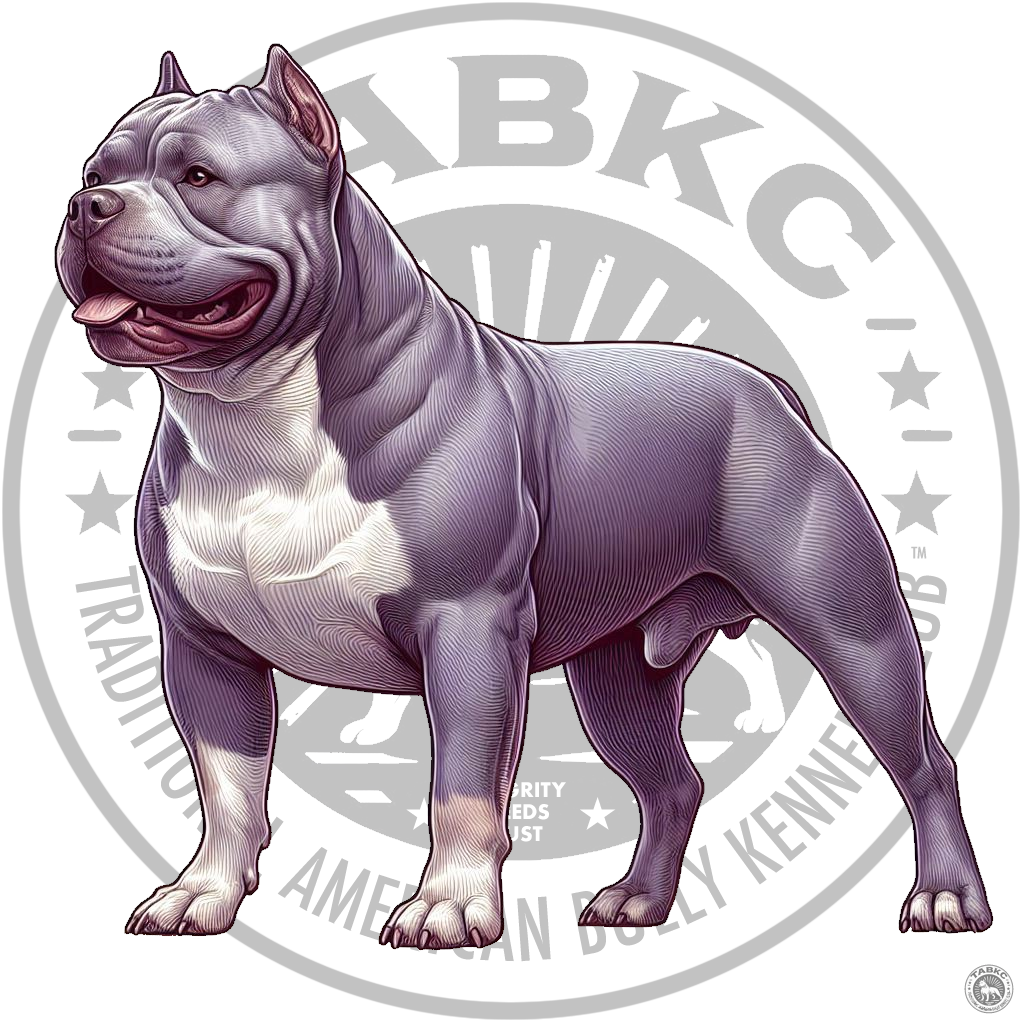


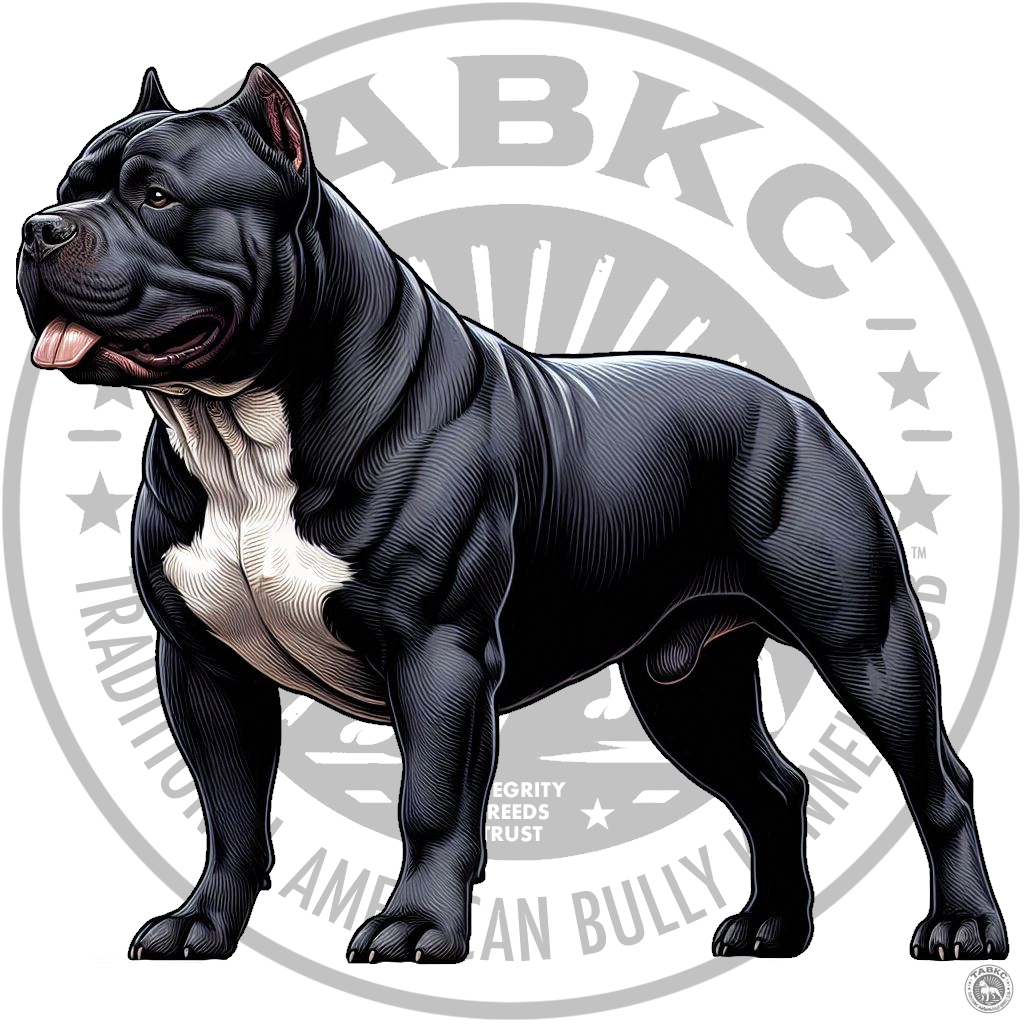

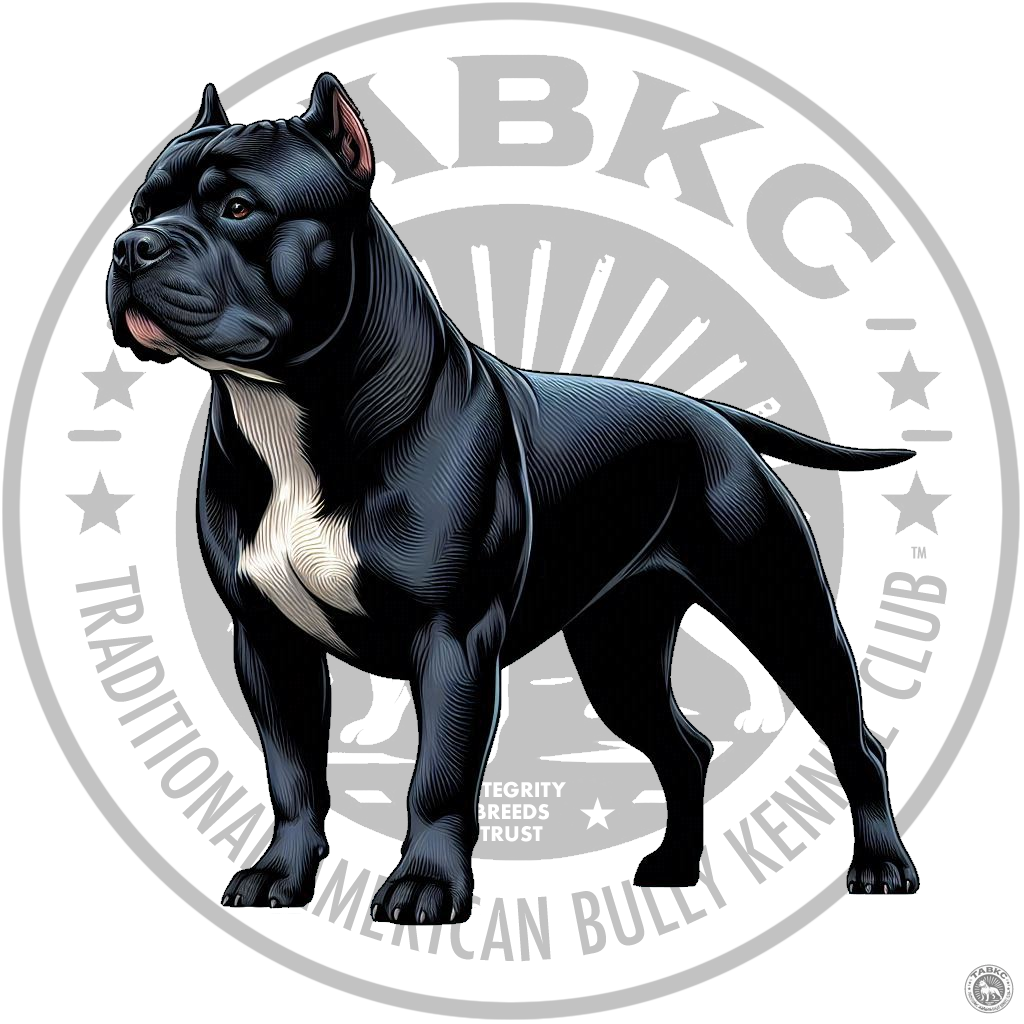
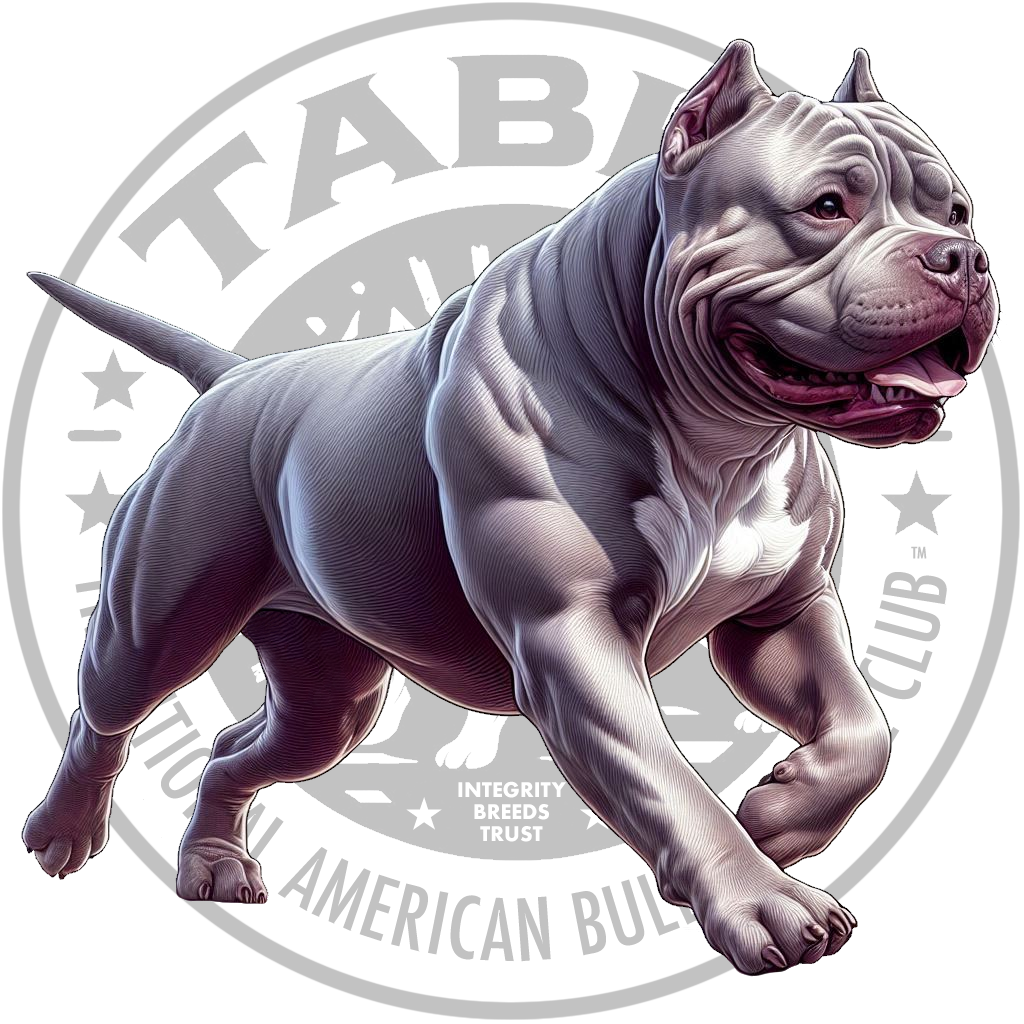
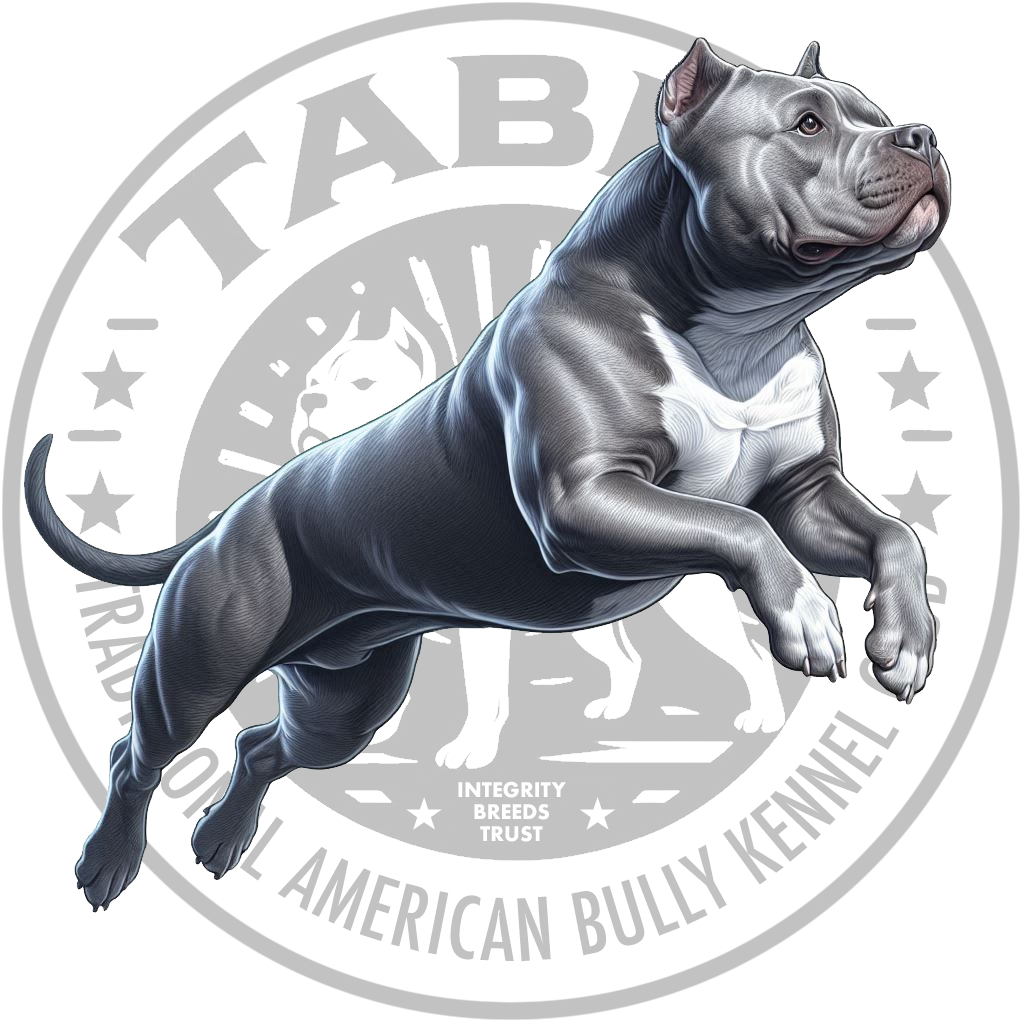
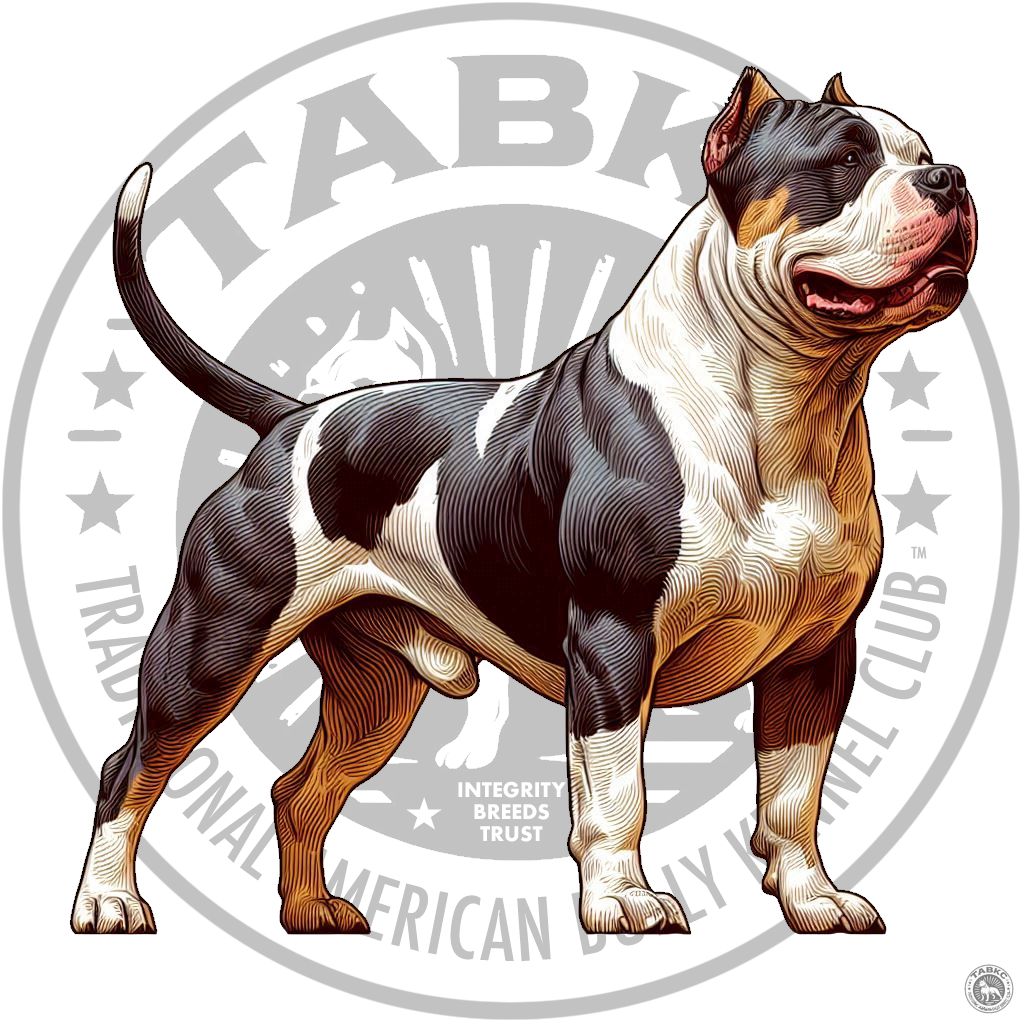
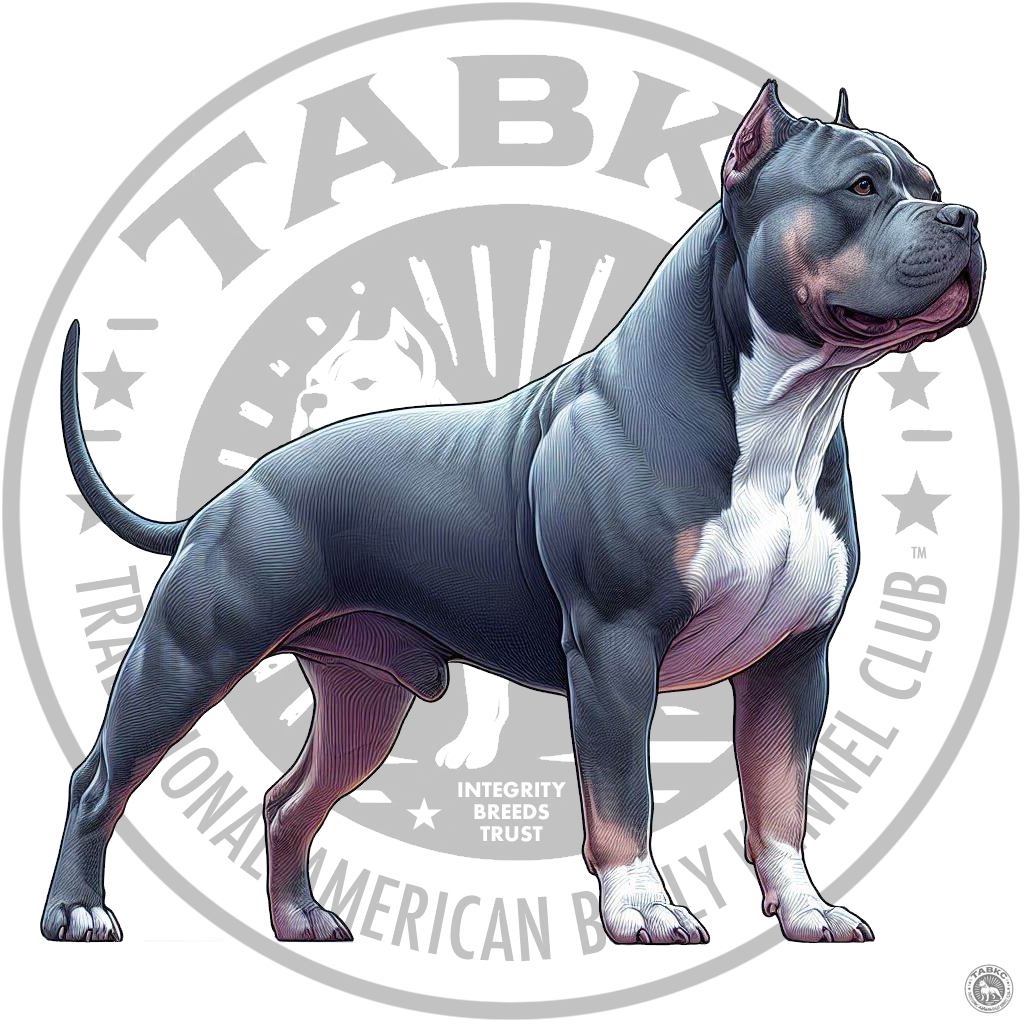
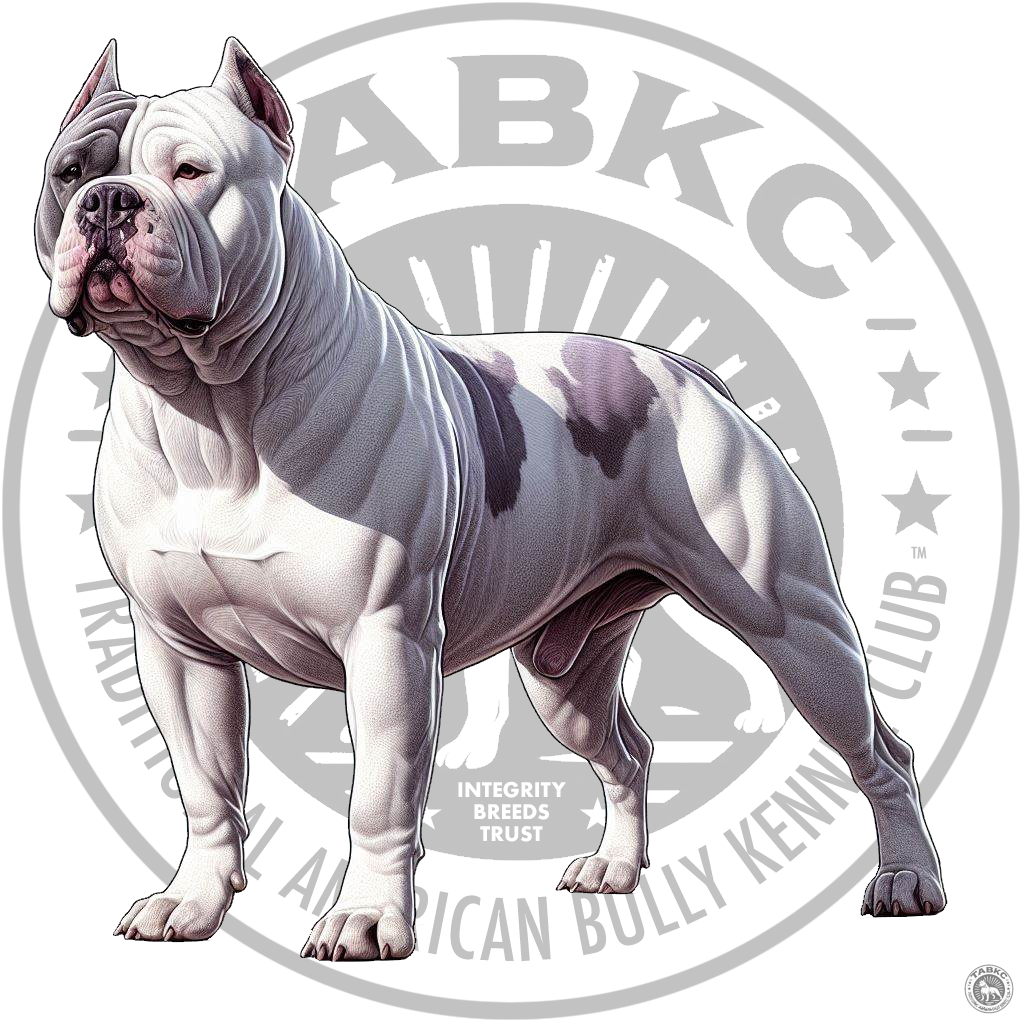
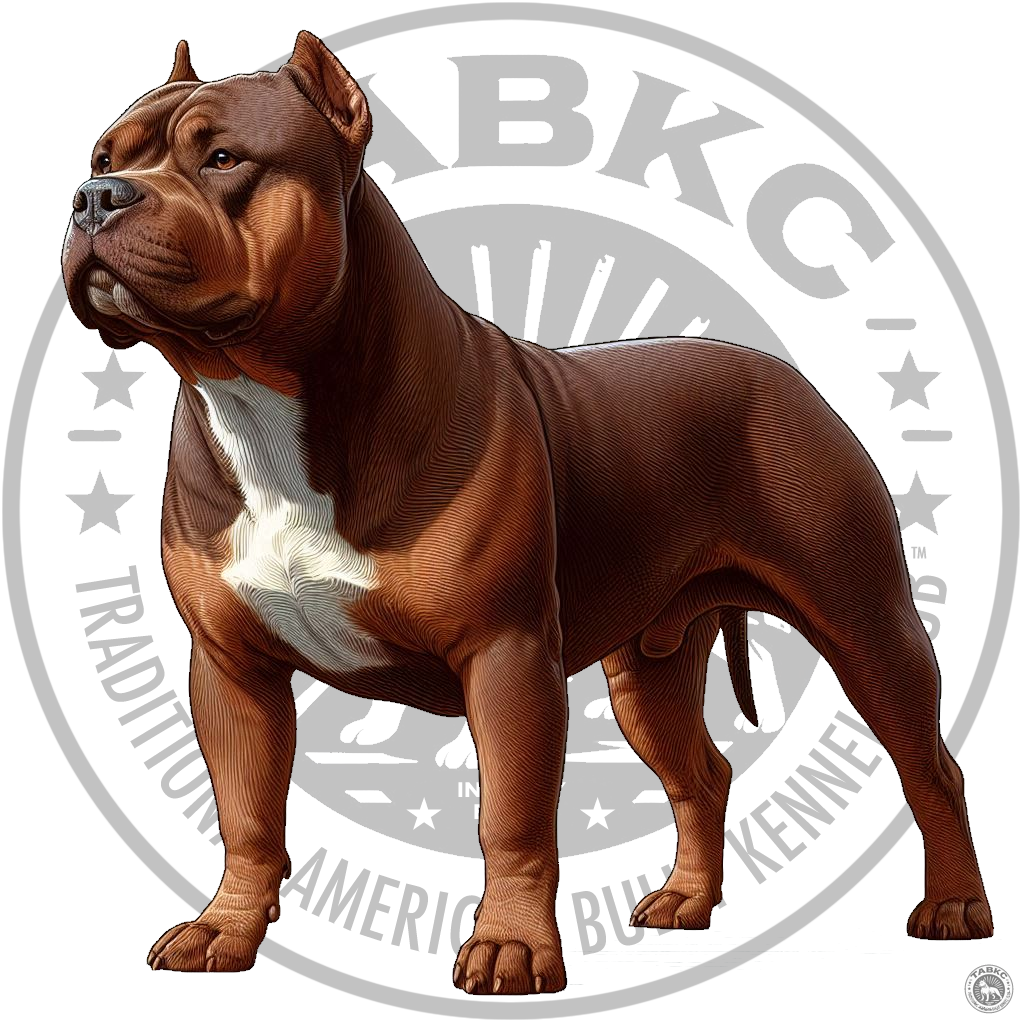

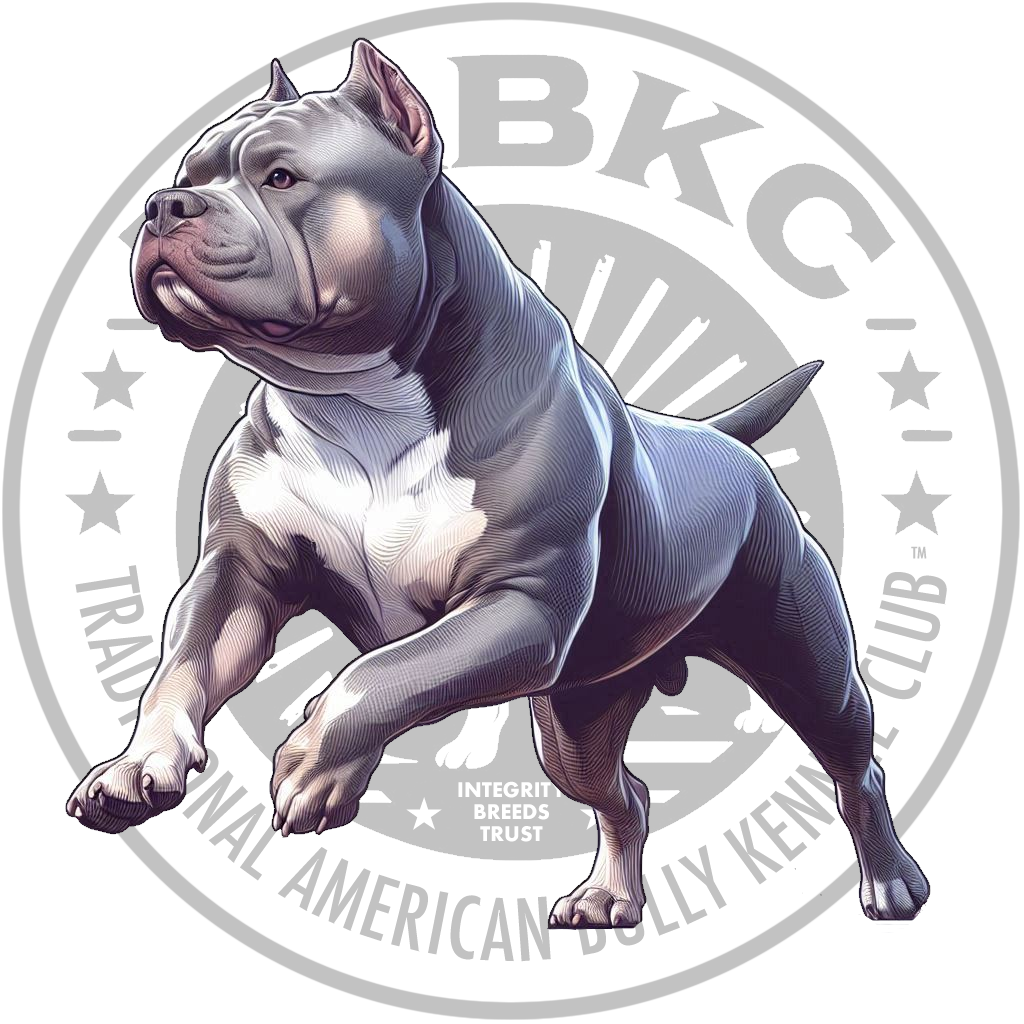

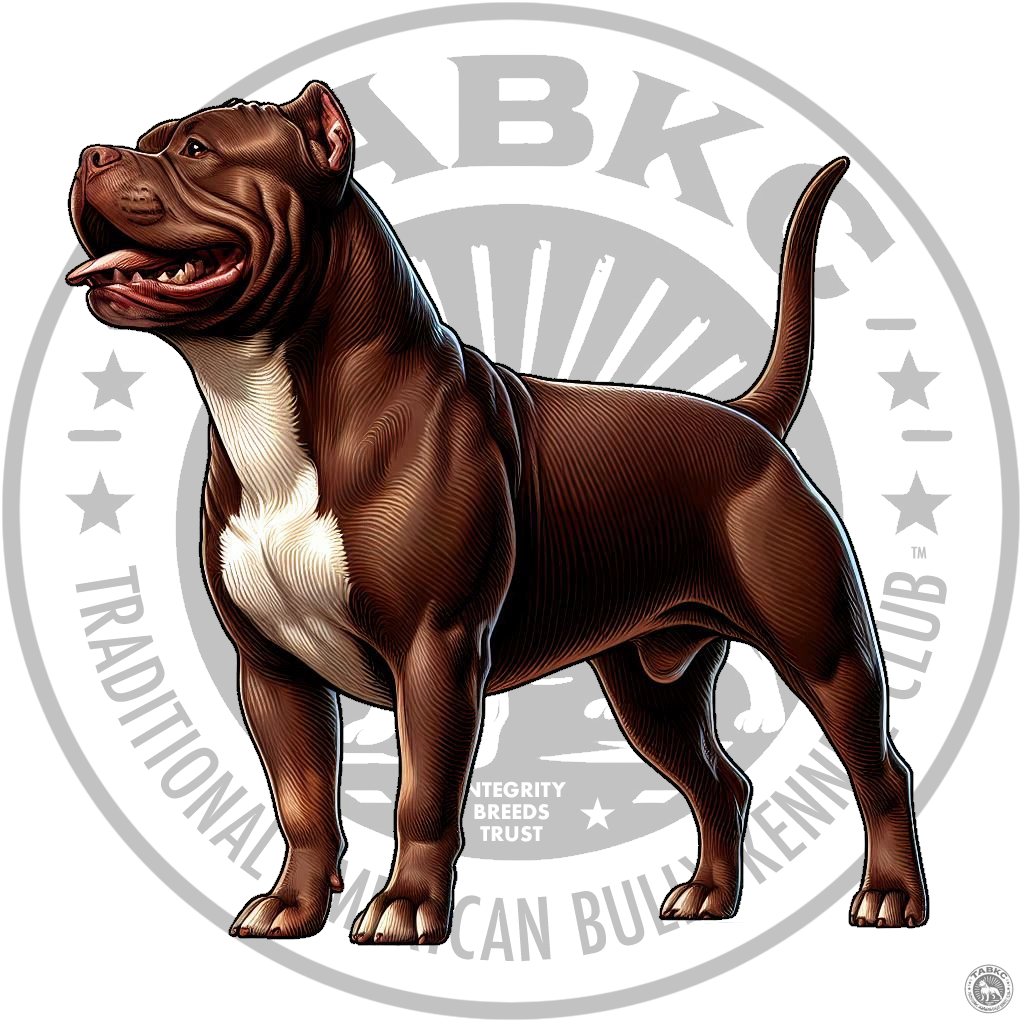
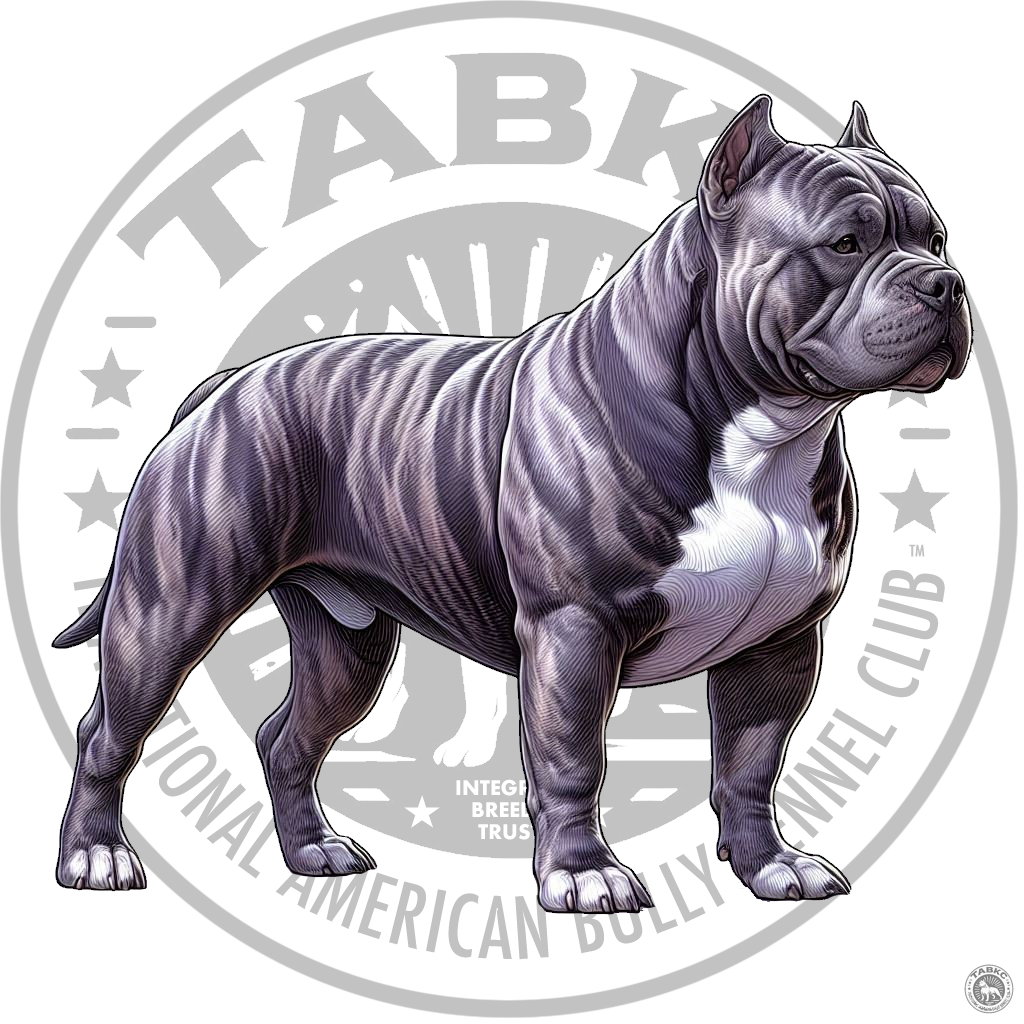
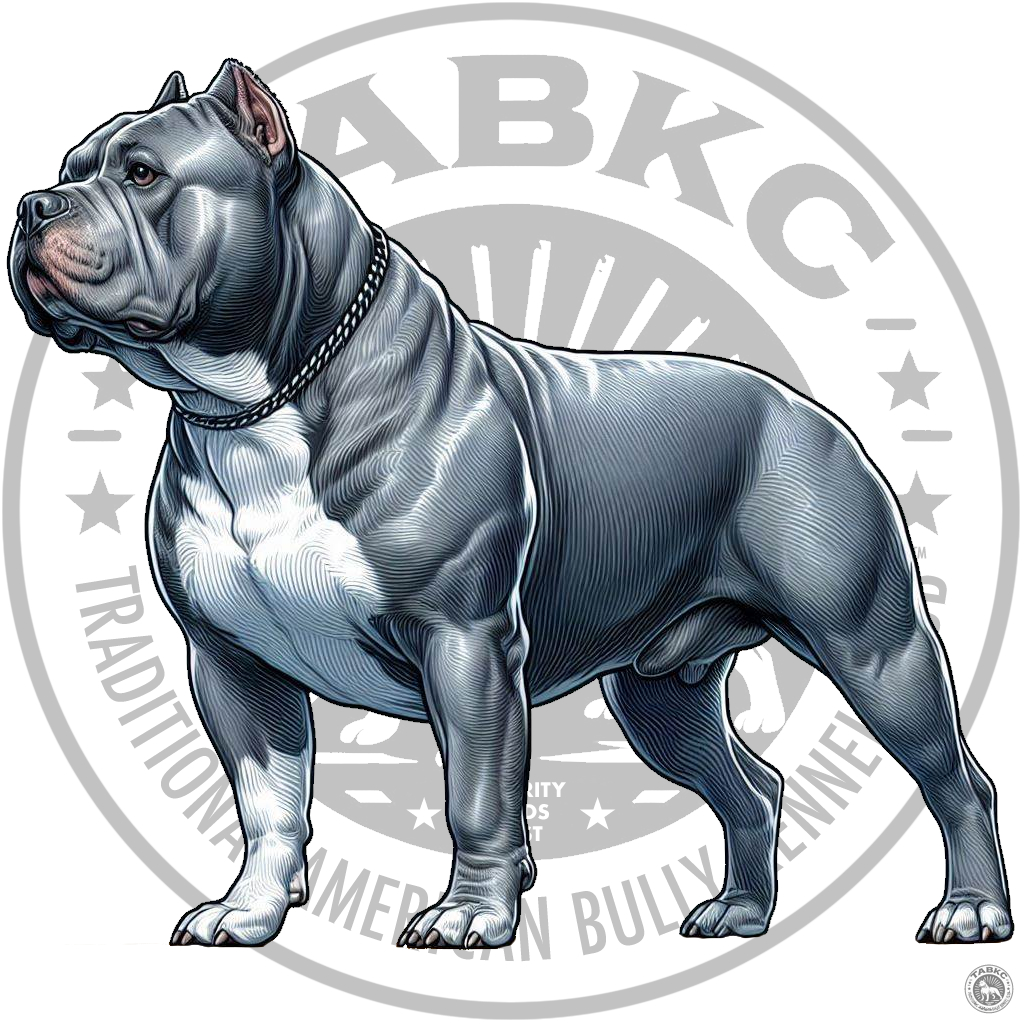
TRADITIONAL VS MODERN
These illustrations represent the general appearance of the Traditional American Bully type versus the Modern American Bully type.
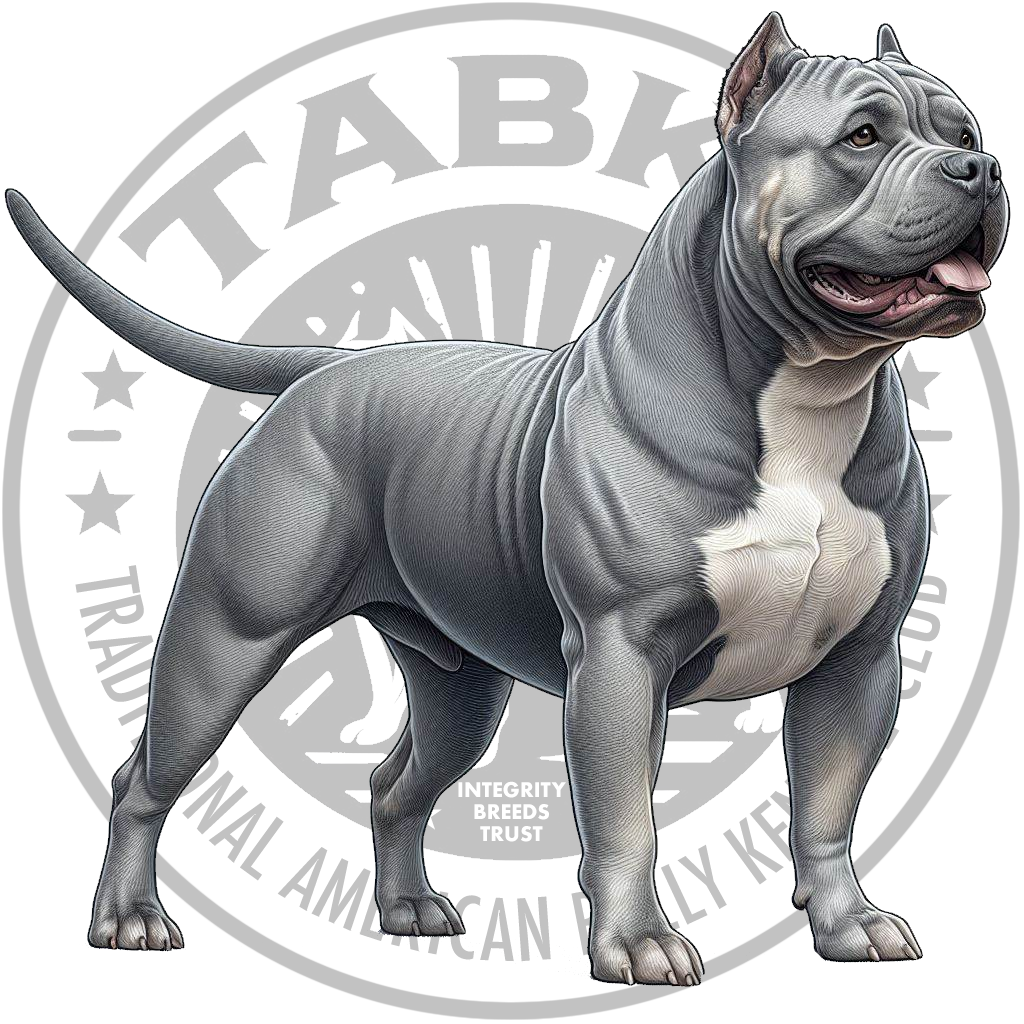
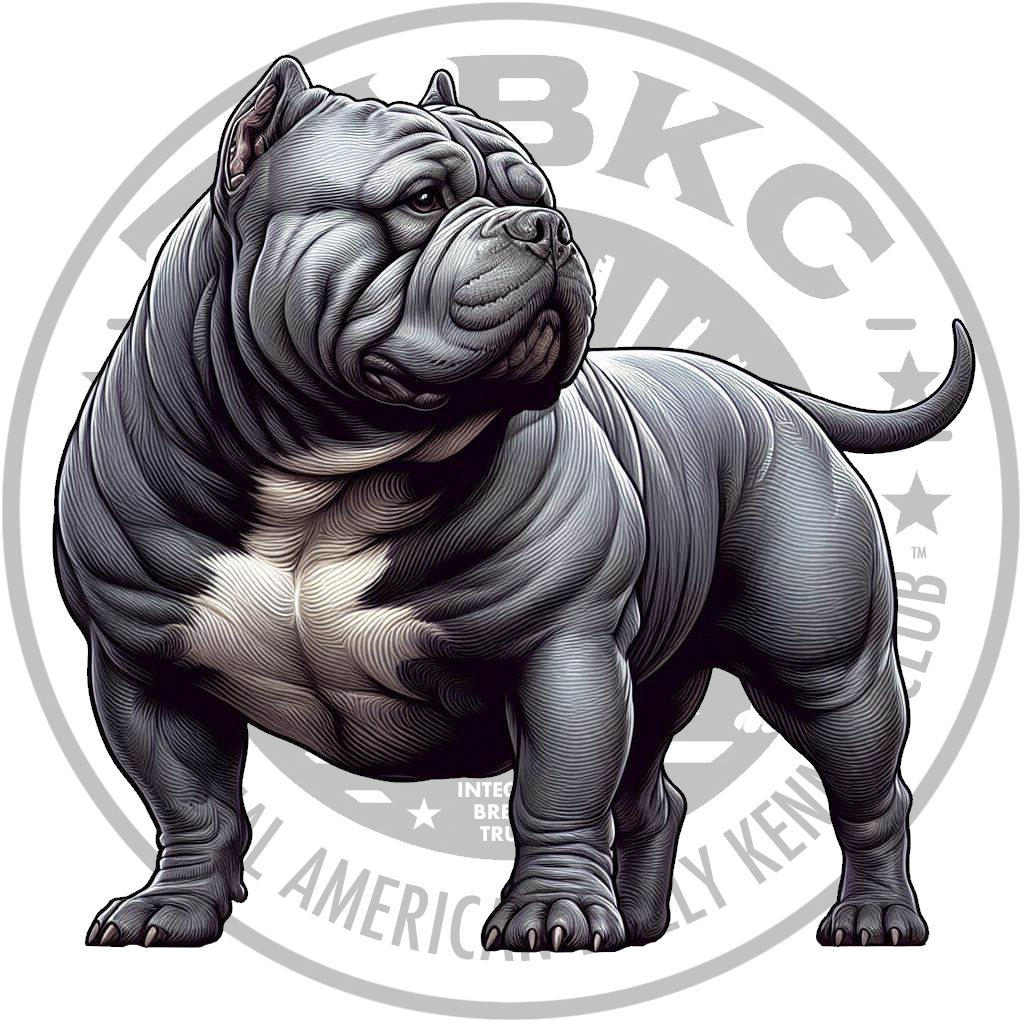
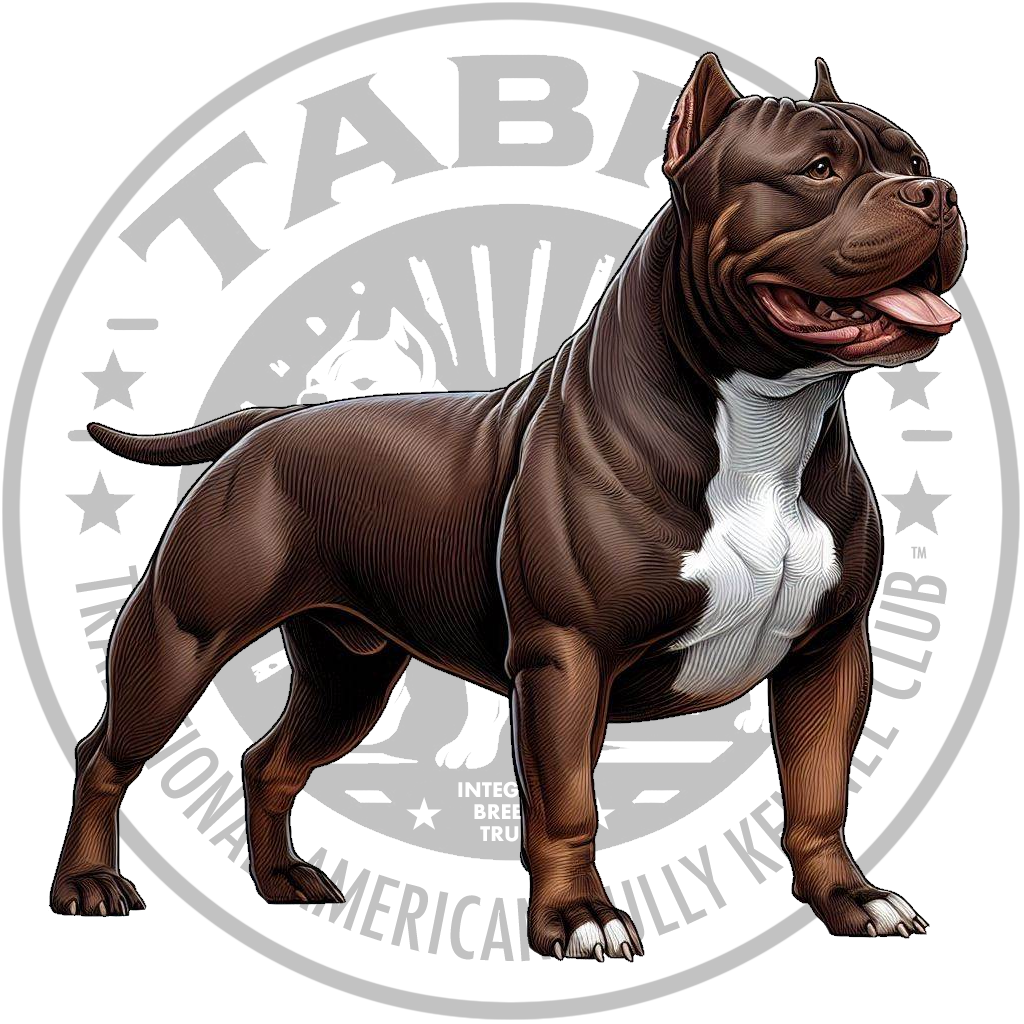

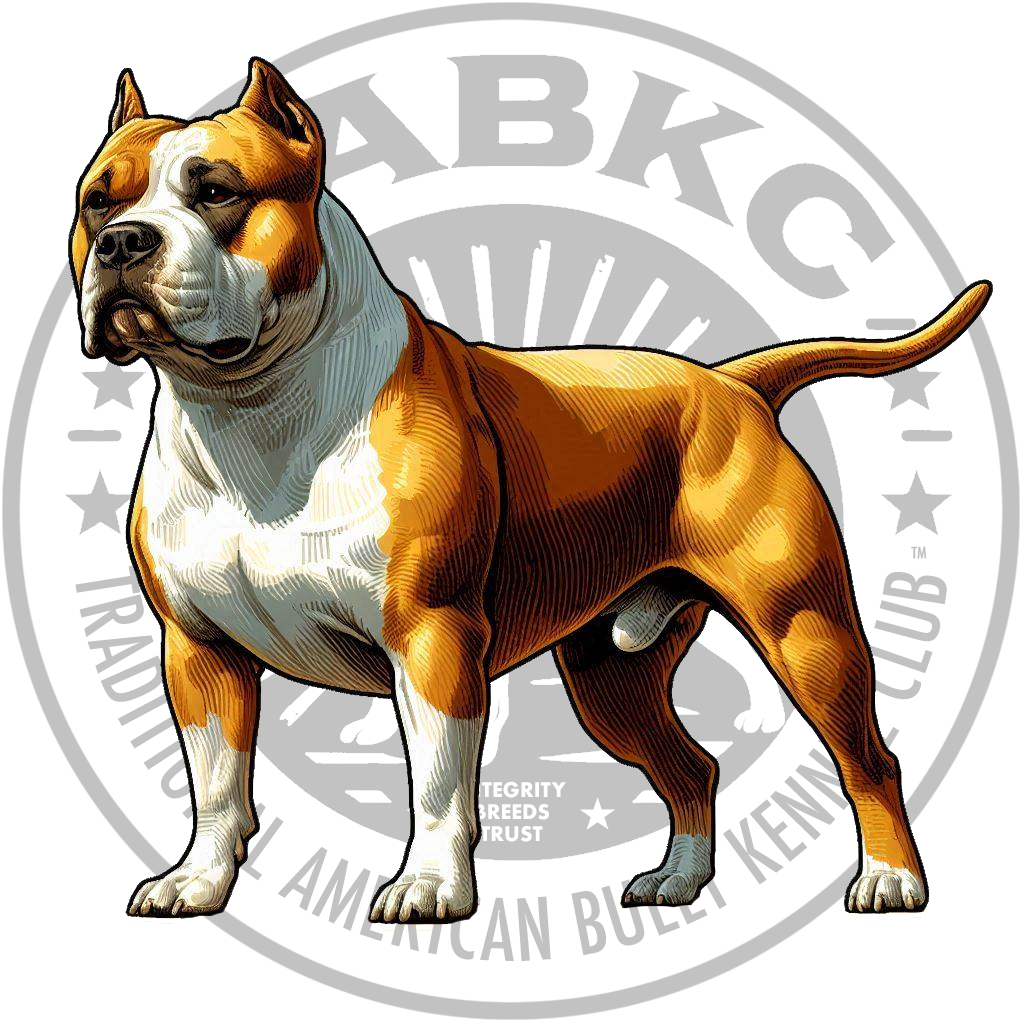
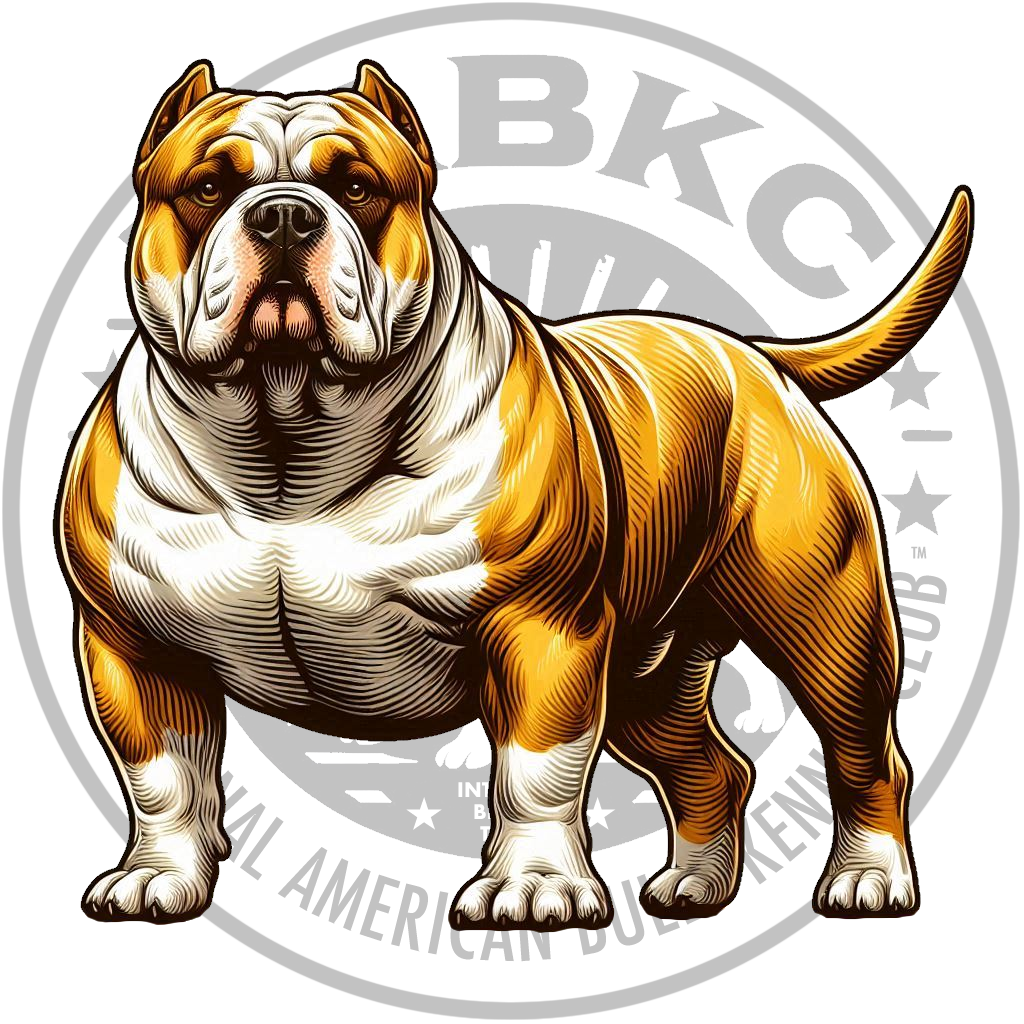
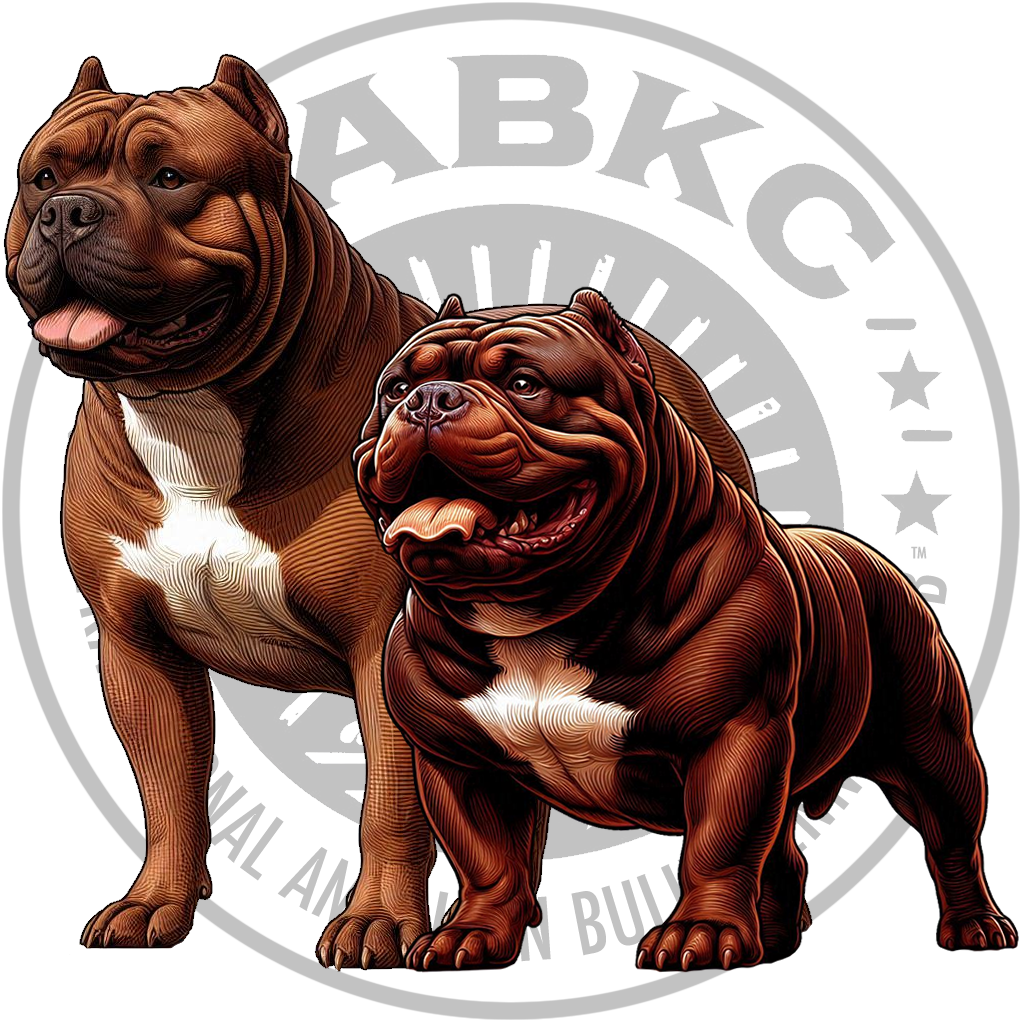
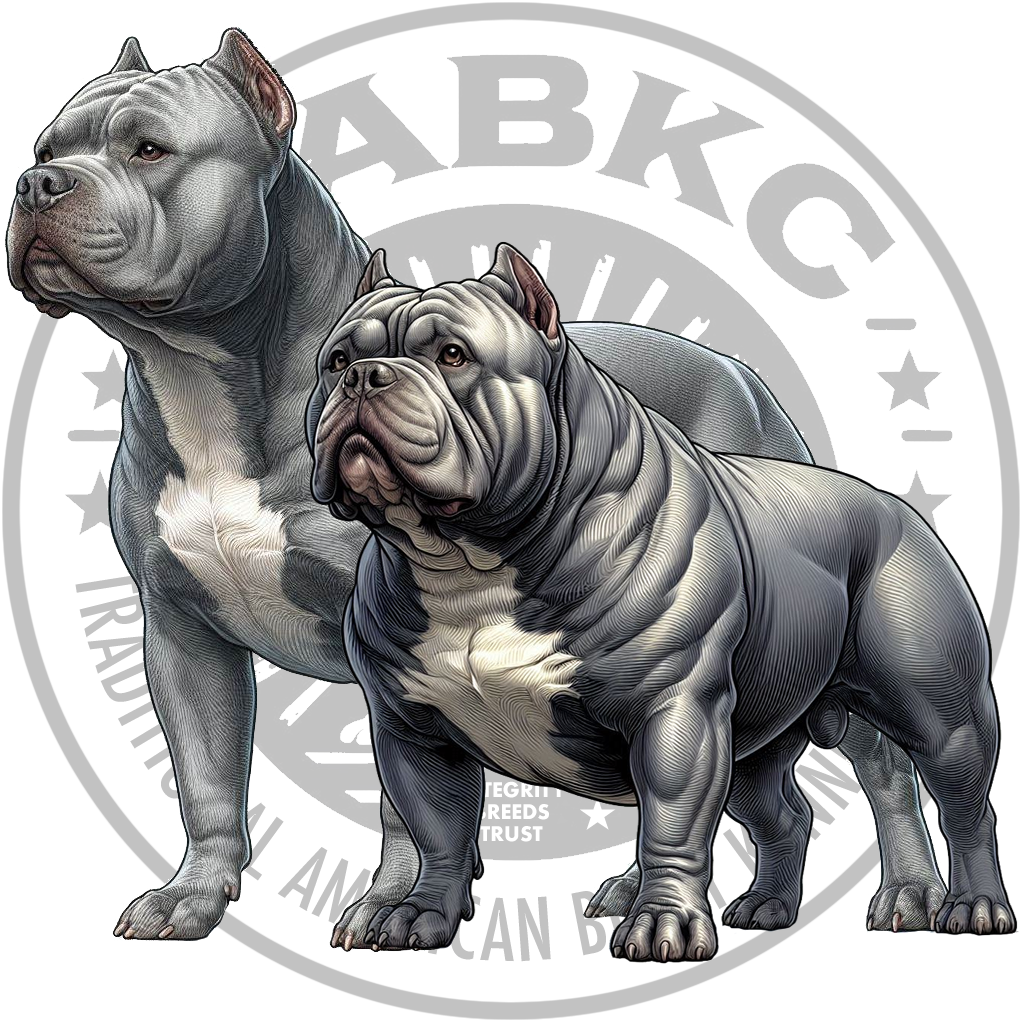
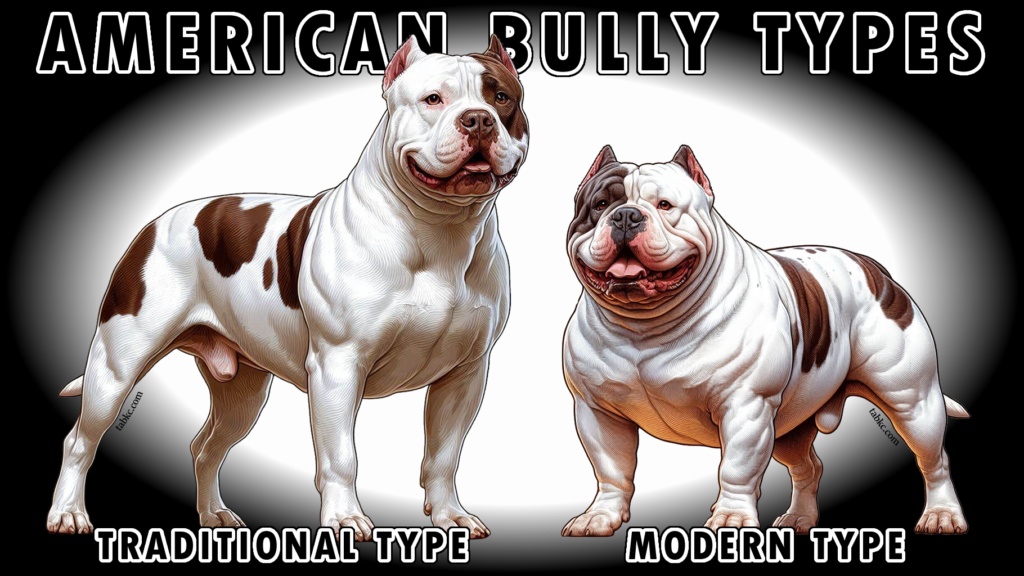
Last Updated: 08/25/2024
This written standard is under development and is currently based on the American Bully breed standard. Future updates should be expected.
